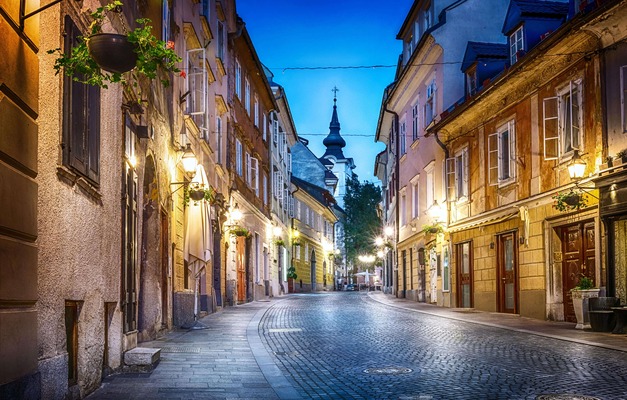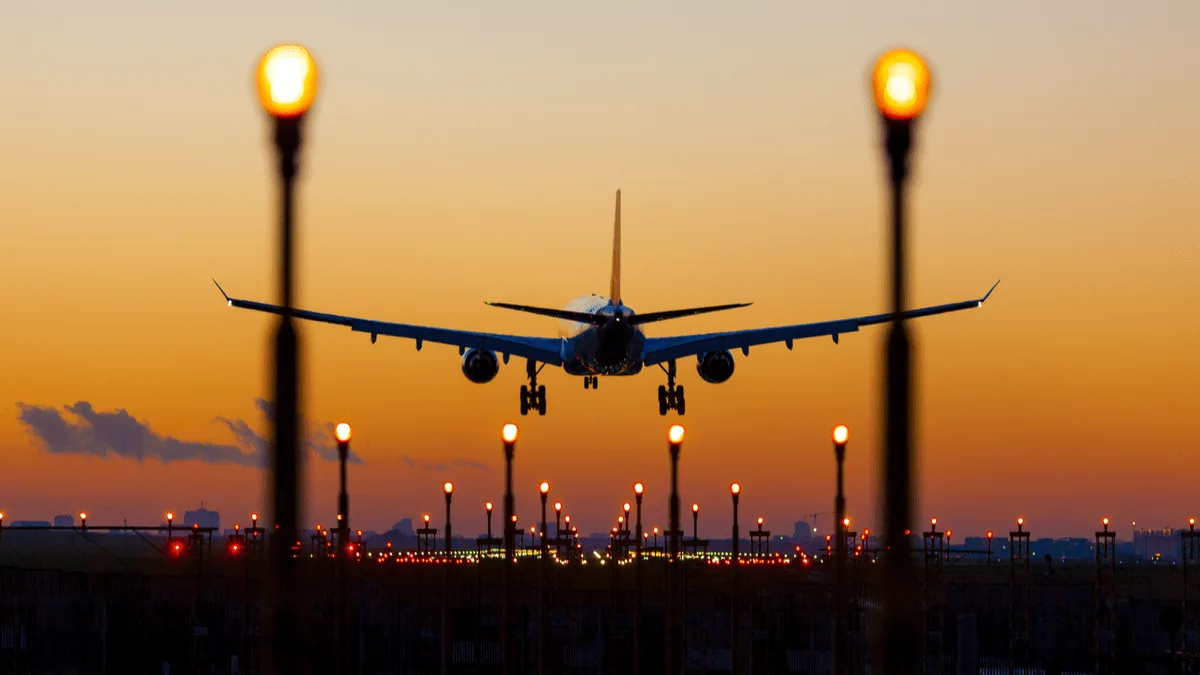
Winter Wonderland: Germany’s Iconic Cities and Alpine Landscapes
 10 Day Tour of Heidelberg, Nuremberg and Munich
10 Day Tour of Heidelberg, Nuremberg and Munich
Overview
Trip Map
Itinerary
Inclusions
Reviews







10 Days 9 Nights
Best Time: Jan-Dec
Exploring Scenic Countryside
History Buffs
Explore Germany's enchanting winter landscapes on this 10-day adventure. Begin your journey in the historic Heidelberg, wandering through medieval streets and climbing to its romantic ruined castle. See Nuremberg's Old Town and imposing Imperial Castle, and take a day trip to picture-perfect Rothenburg ob der Tauber. The bustling city of Munich follows, where modernity meets Bavarian tradition. Discover Germany’s fairy-tale Neuschwanstein Castle and experience the snowy charm of Garmisch-Partenkirchen, nestled in the Alps. Enjoy hearty German cuisine & breathtaking winter vistas, as well as 3 private guided walks and detailed travel guidance.
- Experience a guided tour through the picturesque streets of Heidelberg & cross the famed Old Bridge.
- Discover Nuremberg’s Imperial Castle courtyards on a private guided tour of the Old Town.
- Wander Munich’s charming Altstadt and relax in its renowned beer halls.
- Take a self-guided excursion to Garmisch-Partenkirchen’s Alpine winter wonderland.
- Marvel at the iconic Neuschwanstein Castle, the inspiration for countless fairy tales.
Explore Germany's enchanting winter landscapes on this 10-day adventure. Begin your journey in the historic Heidelberg, wandering through medieval streets and climbing to its romantic ruined castle. See Nuremberg's Old Town and imposing Imperial Castle, and take a day trip to picture-perfect Rothenburg ob der Tauber. The bustling city of Munich follows, where modernity meets Bavarian tradition. Discover Germany’s fairy-tale Neuschwanstein Castle and experience the snowy charm of Garmisch-Partenkirchen, nestled in the Alps. Enjoy hearty German cuisine & breathtaking winter vistas, as well as 3 private guided walks and detailed travel guidance.
- Experience a guided tour through the picturesque streets of Heidelberg & cross the famed Old Bridge.
- Discover Nuremberg’s Imperial Castle courtyards on a private guided tour of the Old Town.
- Wander Munich’s charming Altstadt and relax in its renowned beer halls.
- Take a self-guided excursion to Garmisch-Partenkirchen’s Alpine winter wonderland.
- Marvel at the iconic Neuschwanstein Castle, the inspiration for countless fairy tales.

Heidelberg Castle
Castles & Chateaux

Church of the Holy Spirit
Churches & Monasteries

Old Bridge
Architecture

Nuremberg Castle
Castles & Chateaux

Nazi Rally Grounds
The Great War & WWII

Old Town
Historic Landmarks

Old Town
Architecture

Residence Palace
Castles & Chateaux

Deutsches Museum
Museums & Galleries
Must see sights

Heidelberg Castle
Castles & Chateaux

Church of the Holy Spirit
Churches & Monasteries

Old Bridge
Architecture

Nuremberg Castle
Castles & Chateaux

Nazi Rally Grounds
The Great War & WWII

Old Town
Historic Landmarks

Old Town
Architecture

Residence Palace
Castles & Chateaux

Deutsches Museum
Museums & Galleries
Starting from
$1899
per person
 Not included
Not included Secure Your Customizable Trip
Enter your details to embark on a journey that can be tailored just for you.
Start
Travelers
Add Room
Remove Room
Preferred Hotel Stars
Craft Your Own Itinerary
Select your interests and destinations for a trip plan inspired by you.
Trip Map & Itinerary
Enable/Disable Map Scrolling
Click To Make Map Interactive

Trip Timeline
 Edit Details
Edit DetailsArrival
2 nights
Heidelberg
Germany
Train: 1h
Train: 2h
3 nights
Nuremberg
Germany
Train: 1.5h
4 nights
Munich
Germany
Departure
Day-By-Day Itinerary

Day 1
Arrive Heidelberg
View More
Day 1
Arrive Heidelberg


10:52 - 11:23, 15:59 - 16:16
Rail or Bus from Frankfurt Airport to Heidelberg
Frankfurt Airport is the most convenient airport for those traveling to Heidelberg. Taxis are available directly at the terminal exit, or you can arrange a private transfer for added convenience. Uber is also available. Any of these options though will be very expensive. The cheapest and fastest way to reach Heidelberg is by train or bus. A train station is co-located with the airport, and there are several daily direct trains to Heidelberg's main station, where you can easily hail a much less expensive taxi. If a direct train is not leaving at a convenient time for you, you can take a train which connects in Mannheim - in either case the journey only takes an hour. There are also direct buses which depart from a stop next to the rail station exit.

Day 1
Arrive Heidelberg
View More


Day 1
Arrive Heidelberg



10:52 - 11:23, 15:59 - 16:16:
Train or Bus to Heidelberg
4:16 PM:
Transfer from Rail Station

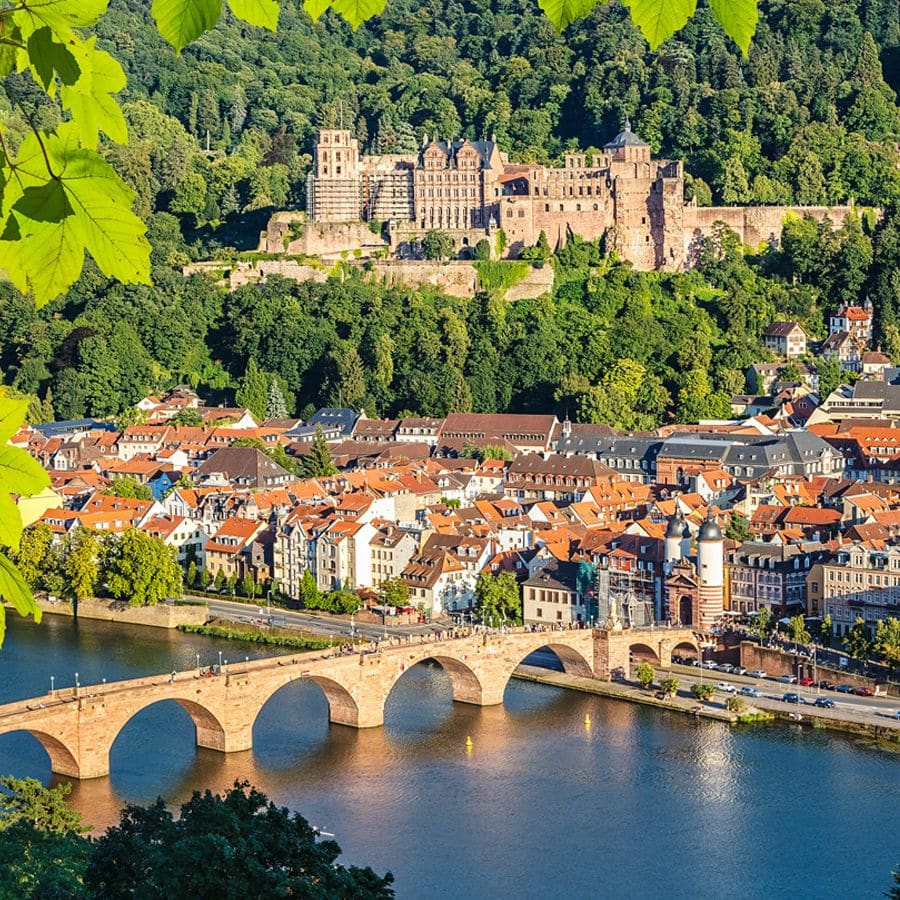
Day 2
Heidelberg
View More
Day 2
Heidelberg



9:00 AM - 1:00 PM
Guided Walking Tour of the Heidelberg's Altstadt and Castle
On this 4 hour tour, your guide will show you the highlights of Heidelberg and help you understand what makes this city so unique. Sites visited will include the Heidelberg University, the Old Bridge, Altstadt, Town Hall and Heidelberg Castle.

Altstadt
The light and colors of this historic city are a happy sight to behold.
Show More

Heidelberg University
Founded in 1386, this is Germany’s oldest and one of its most prestigious universities.
Show More

Altstadt
The light and colors of this historic city are a happy sight to behold.
Show More

Heidelberg University
Founded in 1386, this is Germany’s oldest and one of its most prestigious universities.
Show More

Altstadt
The light and colors of this historic city are a happy sight to behold.
Show More

Heidelberg University
Founded in 1386, this is Germany’s oldest and one of its most prestigious universities.
Show More
prev
next

Day 2
Heidelberg
View More

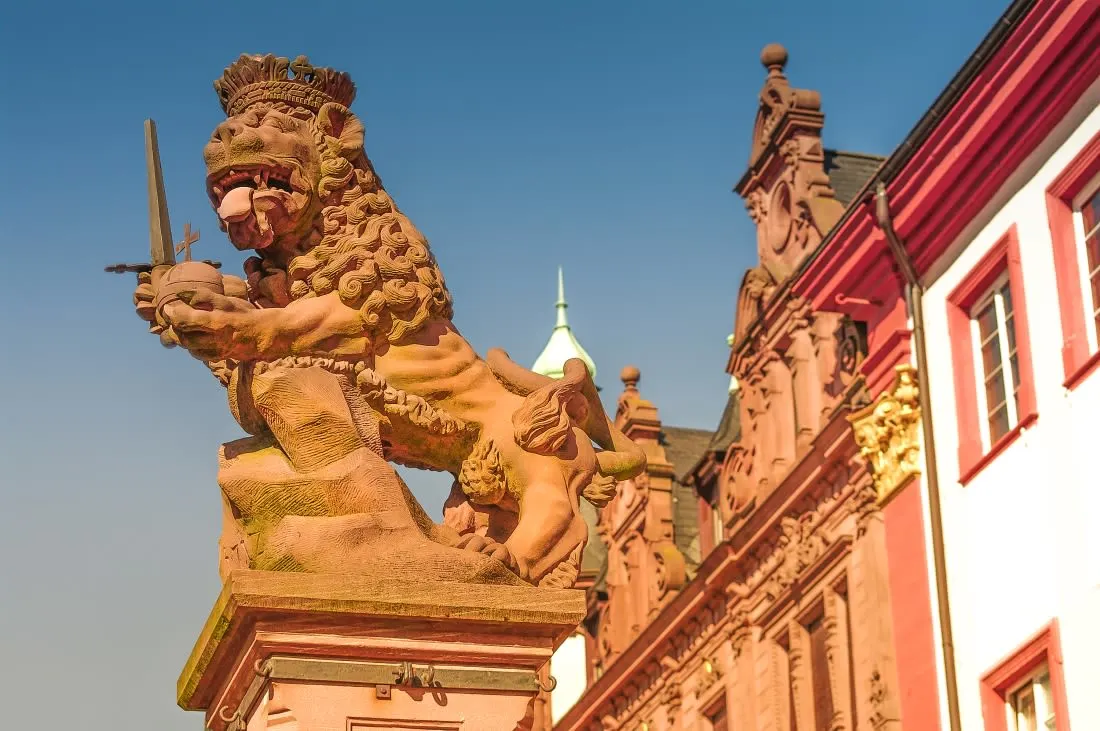
Altstadt
 Highlight of Guided Walking Tour of Heidelberg
Highlight of Guided Walking Tour of HeidelbergThe light and colors of this historic city are a happy sight to behold.
The Old Town of Heidelberg, Germany, seduces with its views. Framed by the Neckar River and overlooked by the majestic Heidelberg Castle, its cobblestone streets, baroque architecture, and the oldest university in Germany beckon visitors. Highlights include the Hauptstrasse, a bustling pedestrian shopping street, and the historic Holy Spirit Church. Heidelberg's Old Town embodies the romantic spirit of Germany.
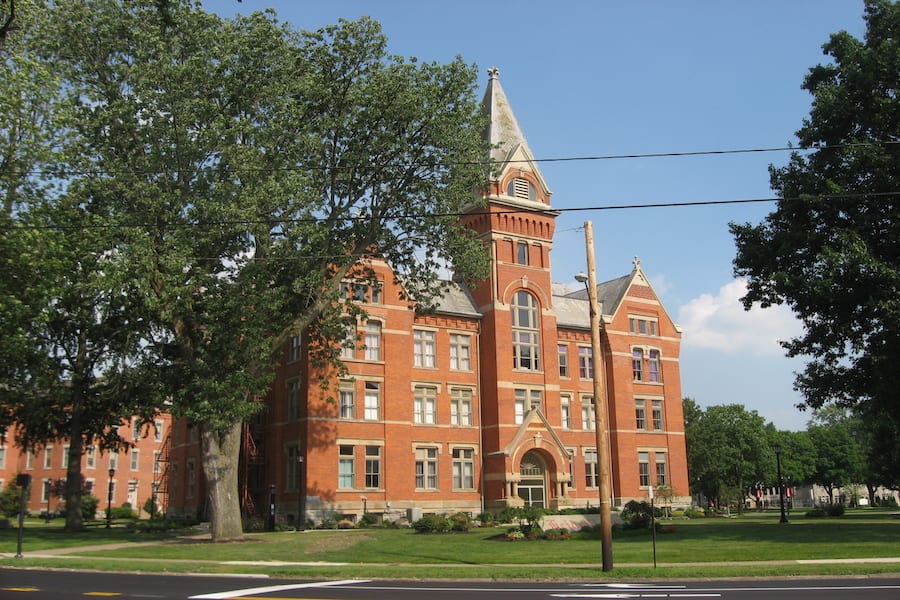
Heidelberg University
 Highlight of Guided Walking Tour of Heidelberg
Highlight of Guided Walking Tour of HeidelbergFounded in 1386, this is Germany’s oldest and one of its most prestigious universities.
The university is currently comprised of 12 faculties with over 30,000 German and international students enrolled. The college is known for its reputable science, art, law, and medical programs. The most historic facilities are located around the Universitätsplatz and dominated by the Alte Universität (Old University, 1712–28; on the south side) and the Neue Universität (New University, 1931; on the north side).

Altstadt
 Highlight of Guided Walking Tour of Heidelberg
Highlight of Guided Walking Tour of HeidelbergThe light and colors of this historic city are a happy sight to behold.
The Old Town of Heidelberg, Germany, seduces with its views. Framed by the Neckar River and overlooked by the majestic Heidelberg Castle, its cobblestone streets, baroque architecture, and the oldest university in Germany beckon visitors. Highlights include the Hauptstrasse, a bustling pedestrian shopping street, and the historic Holy Spirit Church. Heidelberg's Old Town embodies the romantic spirit of Germany.

Heidelberg University
 Highlight of Guided Walking Tour of Heidelberg
Highlight of Guided Walking Tour of HeidelbergFounded in 1386, this is Germany’s oldest and one of its most prestigious universities.
The university is currently comprised of 12 faculties with over 30,000 German and international students enrolled. The college is known for its reputable science, art, law, and medical programs. The most historic facilities are located around the Universitätsplatz and dominated by the Alte Universität (Old University, 1712–28; on the south side) and the Neue Universität (New University, 1931; on the north side).

Altstadt
 Highlight of Guided Walking Tour of Heidelberg
Highlight of Guided Walking Tour of HeidelbergThe light and colors of this historic city are a happy sight to behold.
The Old Town of Heidelberg, Germany, seduces with its views. Framed by the Neckar River and overlooked by the majestic Heidelberg Castle, its cobblestone streets, baroque architecture, and the oldest university in Germany beckon visitors. Highlights include the Hauptstrasse, a bustling pedestrian shopping street, and the historic Holy Spirit Church. Heidelberg's Old Town embodies the romantic spirit of Germany.

Heidelberg University
 Highlight of Guided Walking Tour of Heidelberg
Highlight of Guided Walking Tour of HeidelbergFounded in 1386, this is Germany’s oldest and one of its most prestigious universities.
The university is currently comprised of 12 faculties with over 30,000 German and international students enrolled. The college is known for its reputable science, art, law, and medical programs. The most historic facilities are located around the Universitätsplatz and dominated by the Alte Universität (Old University, 1712–28; on the south side) and the Neue Universität (New University, 1931; on the north side).
prev
next

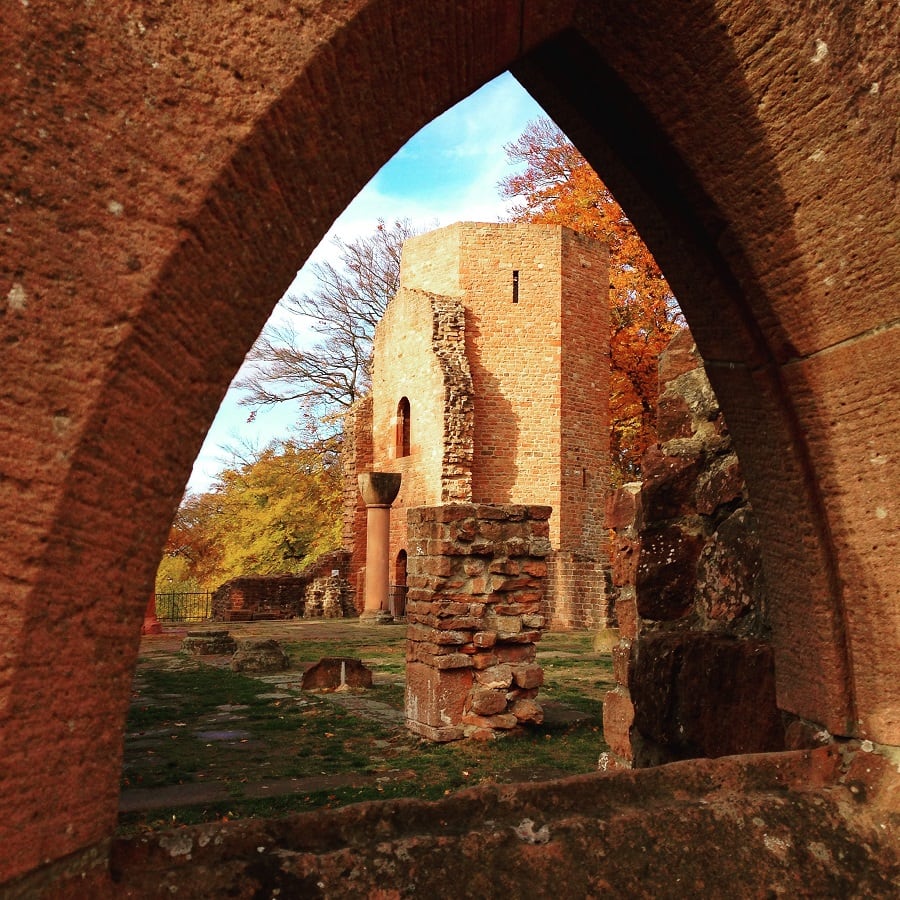
Day 3
Heidelberg to Nuremberg
View More
Day 3
Heidelberg to Nuremberg




Early Morning/Morning
Hike Along the Philosophenweg
Enjoy a gentle hike up into the hills above Heidelberg from the Old Bridge to get magnificent views of the castle on the other side, then trek up further to visit the wonderfully atmospheric ruins of St. Michael's ruins and Thingstätte, the pseudo-Grecian amphitheater built by the Nazis in the mid-1930s to stage opera and theater plays extolling the virtues of the Aryan race.

Thingstätte
Find the open-air amphiteater built by the Nazis as a site for their rallies.
Show More

Monastary Ruins
Discover the isolated ruins at the top of the hill overlooking Heidelberg.
Show More

Thingstätte
Find the open-air amphiteater built by the Nazis as a site for their rallies.
Show More

Monastary Ruins
Discover the isolated ruins at the top of the hill overlooking Heidelberg.
Show More

Thingstätte
Find the open-air amphiteater built by the Nazis as a site for their rallies.
Show More

Monastary Ruins
Discover the isolated ruins at the top of the hill overlooking Heidelberg.
Show More
prev
next

Day 3
Heidelberg to Nuremberg
View More

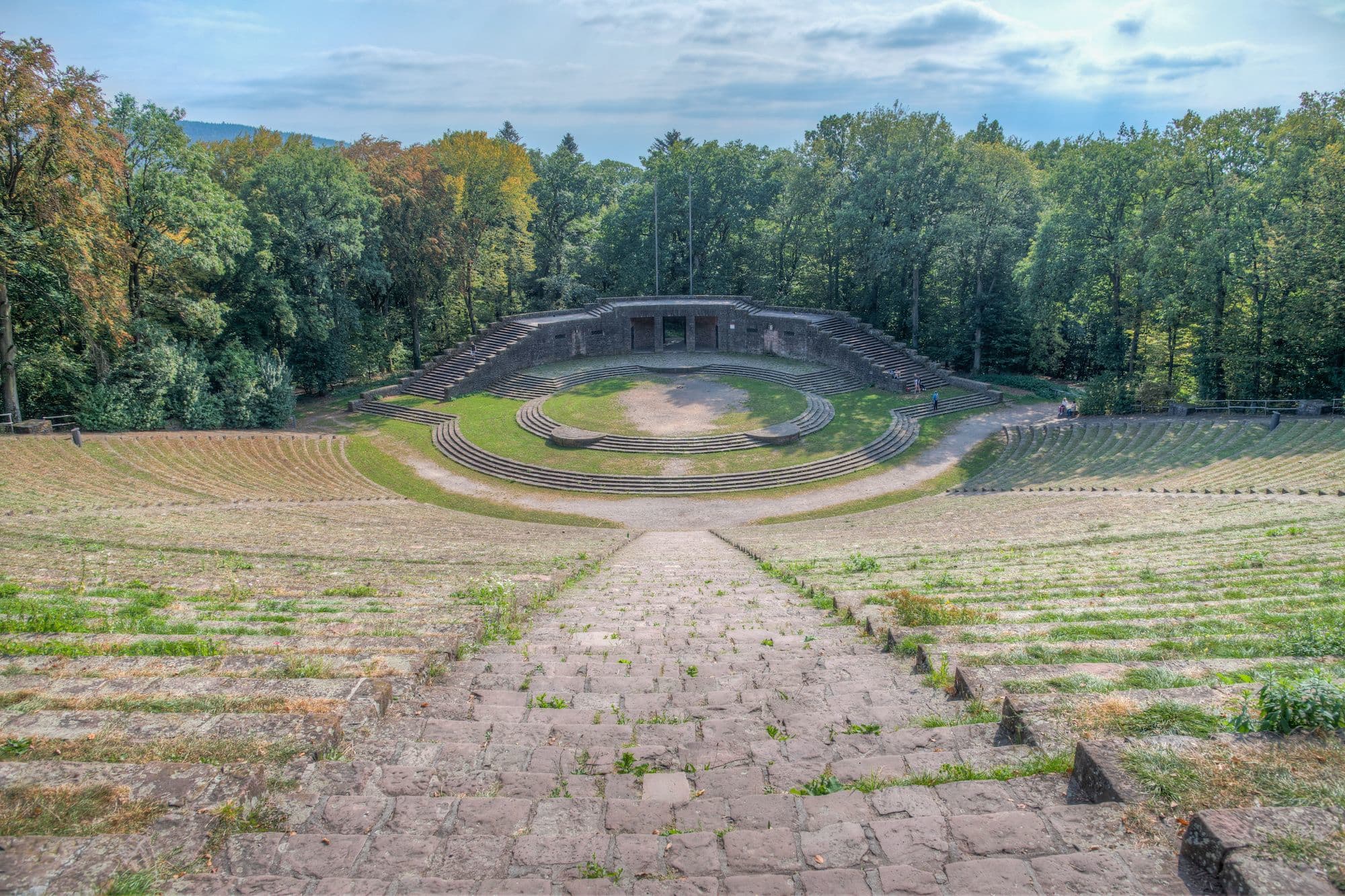
Thingstätte
 Highlight of Philospher's Way Hike
Highlight of Philospher's Way HikeFind the open-air amphiteater built by the Nazis as a site for their rallies.
This open-air amphitheater was built in 1935 by the Nazi party and was designed by Heidelberg native Albert Speer.It was used by the Nazi party during WWII for rallies and solstice festivals. It is now preserved as a monument, but it is still used for many festivals and cultural events throughout the year.

Monastary Ruins
 Highlight of Philospher's Way Hike
Highlight of Philospher's Way HikeDiscover the isolated ruins at the top of the hill overlooking Heidelberg.
In 1023, Abbot Reginbald, who later became Bishop of Speyer, built St. Michael’s Monastery, and it is these remains which are still visible today. After the death of Abbott Friedrich in 1070, the monastery became a place of pilgrimage. In 1503, the last three monks living in the monastery were killed in their beds when part of the steeple collapsed. After that, the monastery became abandoned and was forgotten.

Thingstätte
 Highlight of Philospher's Way Hike
Highlight of Philospher's Way HikeFind the open-air amphiteater built by the Nazis as a site for their rallies.
This open-air amphitheater was built in 1935 by the Nazi party and was designed by Heidelberg native Albert Speer.It was used by the Nazi party during WWII for rallies and solstice festivals. It is now preserved as a monument, but it is still used for many festivals and cultural events throughout the year.

Monastary Ruins
 Highlight of Philospher's Way Hike
Highlight of Philospher's Way HikeDiscover the isolated ruins at the top of the hill overlooking Heidelberg.
In 1023, Abbot Reginbald, who later became Bishop of Speyer, built St. Michael’s Monastery, and it is these remains which are still visible today. After the death of Abbott Friedrich in 1070, the monastery became a place of pilgrimage. In 1503, the last three monks living in the monastery were killed in their beds when part of the steeple collapsed. After that, the monastery became abandoned and was forgotten.

Thingstätte
 Highlight of Philospher's Way Hike
Highlight of Philospher's Way HikeFind the open-air amphiteater built by the Nazis as a site for their rallies.
This open-air amphitheater was built in 1935 by the Nazi party and was designed by Heidelberg native Albert Speer.It was used by the Nazi party during WWII for rallies and solstice festivals. It is now preserved as a monument, but it is still used for many festivals and cultural events throughout the year.

Monastary Ruins
 Highlight of Philospher's Way Hike
Highlight of Philospher's Way HikeDiscover the isolated ruins at the top of the hill overlooking Heidelberg.
In 1023, Abbot Reginbald, who later became Bishop of Speyer, built St. Michael’s Monastery, and it is these remains which are still visible today. After the death of Abbott Friedrich in 1070, the monastery became a place of pilgrimage. In 1503, the last three monks living in the monastery were killed in their beds when part of the steeple collapsed. After that, the monastery became abandoned and was forgotten.
prev
next

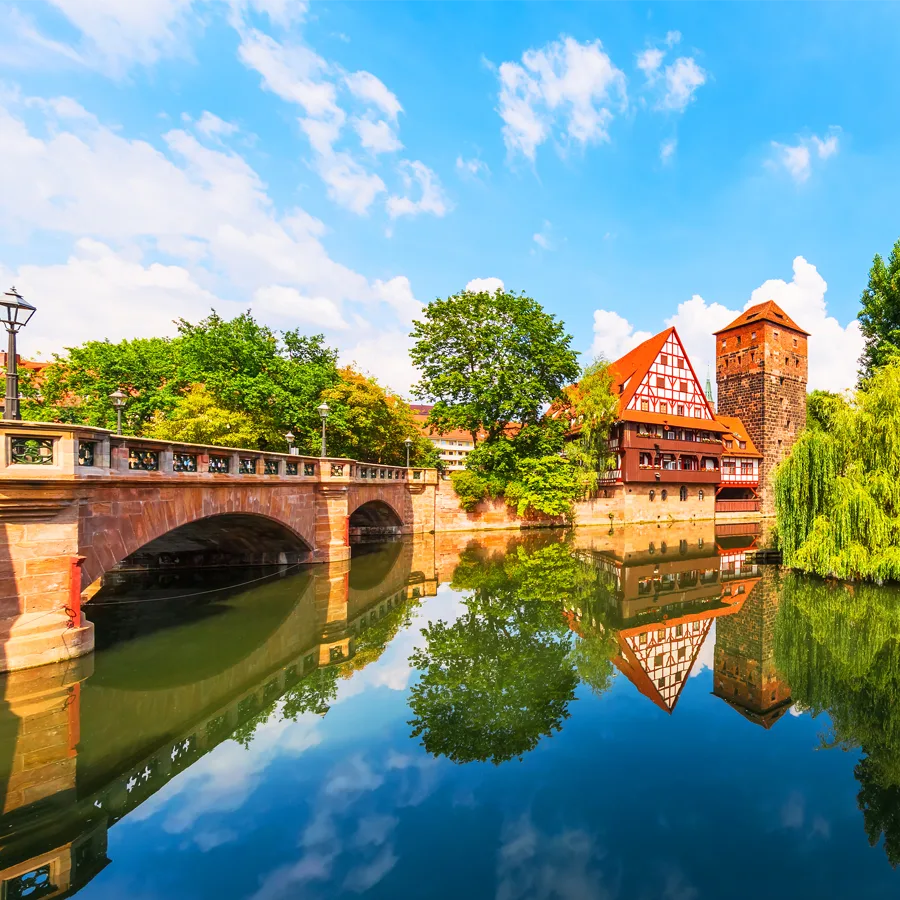
Day 4
Nuremberg
View More
Day 4
Nuremberg



9:00 AM - 11:00 AM
Guided Walking Tour of Nuremberg's Old Town & Imperial Castle Courtyards
Discover a truly extraordinarily place on this 2-hour private guided walking tour of Nuremberg’s medieval walled old city. Enjoy a pleasant walk around the Old Town, passing churches, art treasures, wells and fountains as you make your way up to the Imperial Castle. Explore the outer courtyards with your guide before returning to the Main Market Place.

Old Town Hall
See the most iconic building in Bamberg, precariously perched on an island in the river.
Show More

Old Town Hall
See the most iconic building in Bamberg, precariously perched on an island in the river.
Show More

Old Town Hall
See the most iconic building in Bamberg, precariously perched on an island in the river.
Show More

Old Town Hall
See the most iconic building in Bamberg, precariously perched on an island in the river.
Show More

Old Town Hall
See the most iconic building in Bamberg, precariously perched on an island in the river.
Show More
prev
next

Day 4
Nuremberg
View More

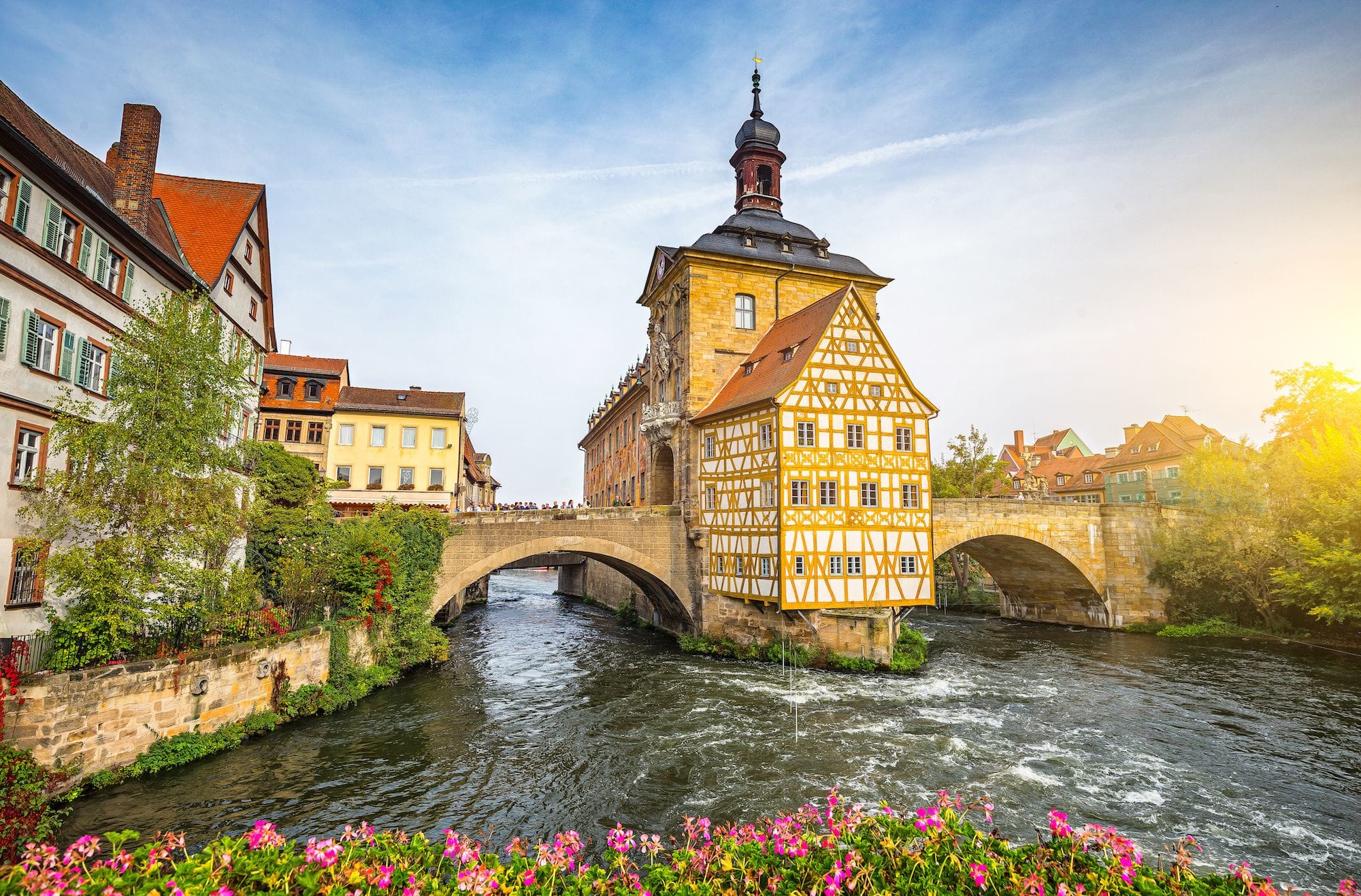
Old Town Hall
 Highlight of Guided Walking Tour of Nuremberg
Highlight of Guided Walking Tour of NurembergSee the most iconic building in Bamberg, precariously perched on an island in the river.
According to legend, it was built on an artificial island because the bishop of Bamberg would not grant the citizens any land for its construction. It is one of the most beautiful buildings in the Old Town, particularly due to its wonderful frescoes that depict the story of how the building came to be built on the island.

Old Town Hall
 Highlight of Guided Walking Tour of Nuremberg
Highlight of Guided Walking Tour of NurembergSee the most iconic building in Bamberg, precariously perched on an island in the river.
According to legend, it was built on an artificial island because the bishop of Bamberg would not grant the citizens any land for its construction. It is one of the most beautiful buildings in the Old Town, particularly due to its wonderful frescoes that depict the story of how the building came to be built on the island.

Old Town Hall
 Highlight of Guided Walking Tour of Nuremberg
Highlight of Guided Walking Tour of NurembergSee the most iconic building in Bamberg, precariously perched on an island in the river.
According to legend, it was built on an artificial island because the bishop of Bamberg would not grant the citizens any land for its construction. It is one of the most beautiful buildings in the Old Town, particularly due to its wonderful frescoes that depict the story of how the building came to be built on the island.

Old Town Hall
 Highlight of Guided Walking Tour of Nuremberg
Highlight of Guided Walking Tour of NurembergSee the most iconic building in Bamberg, precariously perched on an island in the river.
According to legend, it was built on an artificial island because the bishop of Bamberg would not grant the citizens any land for its construction. It is one of the most beautiful buildings in the Old Town, particularly due to its wonderful frescoes that depict the story of how the building came to be built on the island.

Old Town Hall
 Highlight of Guided Walking Tour of Nuremberg
Highlight of Guided Walking Tour of NurembergSee the most iconic building in Bamberg, precariously perched on an island in the river.
According to legend, it was built on an artificial island because the bishop of Bamberg would not grant the citizens any land for its construction. It is one of the most beautiful buildings in the Old Town, particularly due to its wonderful frescoes that depict the story of how the building came to be built on the island.
prev
next

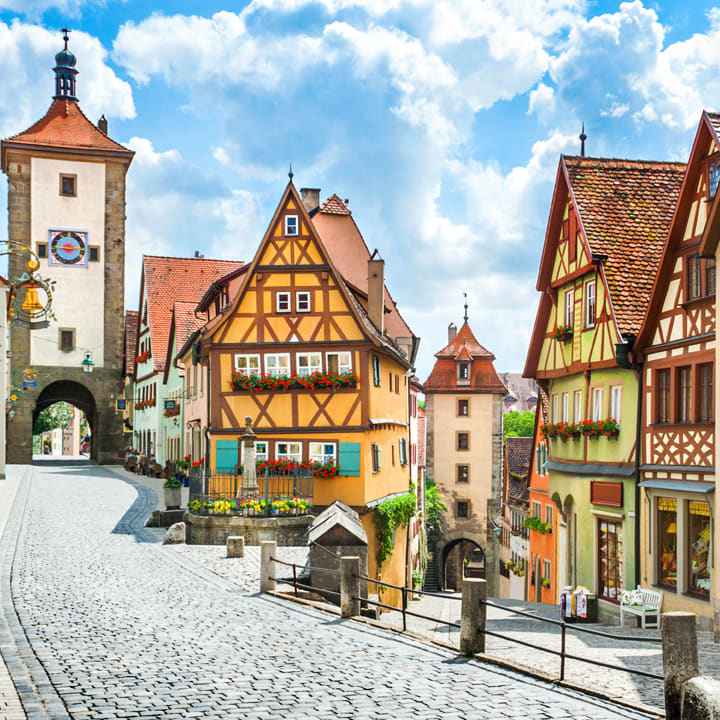
Day 5
Nuremberg
View More
Day 5
Nuremberg

Early Morning to Late Afternoon
Excursion to Rothenburg ob der Tauber
Massive stone walls studded with 42 towers; half-timbered colorful houses with red-tiled roofs; cobblestone streets and flower-filled window boxes: this is Rothenburg ob der Tauber, one of the most fairy-tale towns in all of Europe, and the most popular stop on Germany's famous "Romantic Road". This little slice of storybook heaven is one of the most photographed towns in Europe, with thousands of visitors from all over the world coming to experience its magical atmosphere. If traveling by train, it is located only a little more than an hour from Nuremberg, although you will need to make two connections on the journey.

Imperial Town Museum
Take a peek at what may be Germany's oldest kitchen and learn a bit of local lore and history.
Show More

Rothenburg City Wall
Peer over the red rooftops of Rothenburg as you walk its centuries-old battlements.
Show More

Christmas Store & German Christmas Museum
Experience a traditional German Christmas, regardless of when you visit.
Show More

Rothenburg Market Square
Stop for a coffee or beer and enjoy the ambience in this lovely square.
Show More

Plönlein (Little Square)
See one of the most photographed spots in Europe with your own eyes.
Show More

Imperial Town Museum
Take a peek at what may be Germany's oldest kitchen and learn a bit of local lore and history.
Show More

Rothenburg City Wall
Peer over the red rooftops of Rothenburg as you walk its centuries-old battlements.
Show More

Christmas Store & German Christmas Museum
Experience a traditional German Christmas, regardless of when you visit.
Show More

Rothenburg Market Square
Stop for a coffee or beer and enjoy the ambience in this lovely square.
Show More

Plönlein (Little Square)
See one of the most photographed spots in Europe with your own eyes.
Show More

Imperial Town Museum
Take a peek at what may be Germany's oldest kitchen and learn a bit of local lore and history.
Show More
prev
next

Day 5
Nuremberg
View More

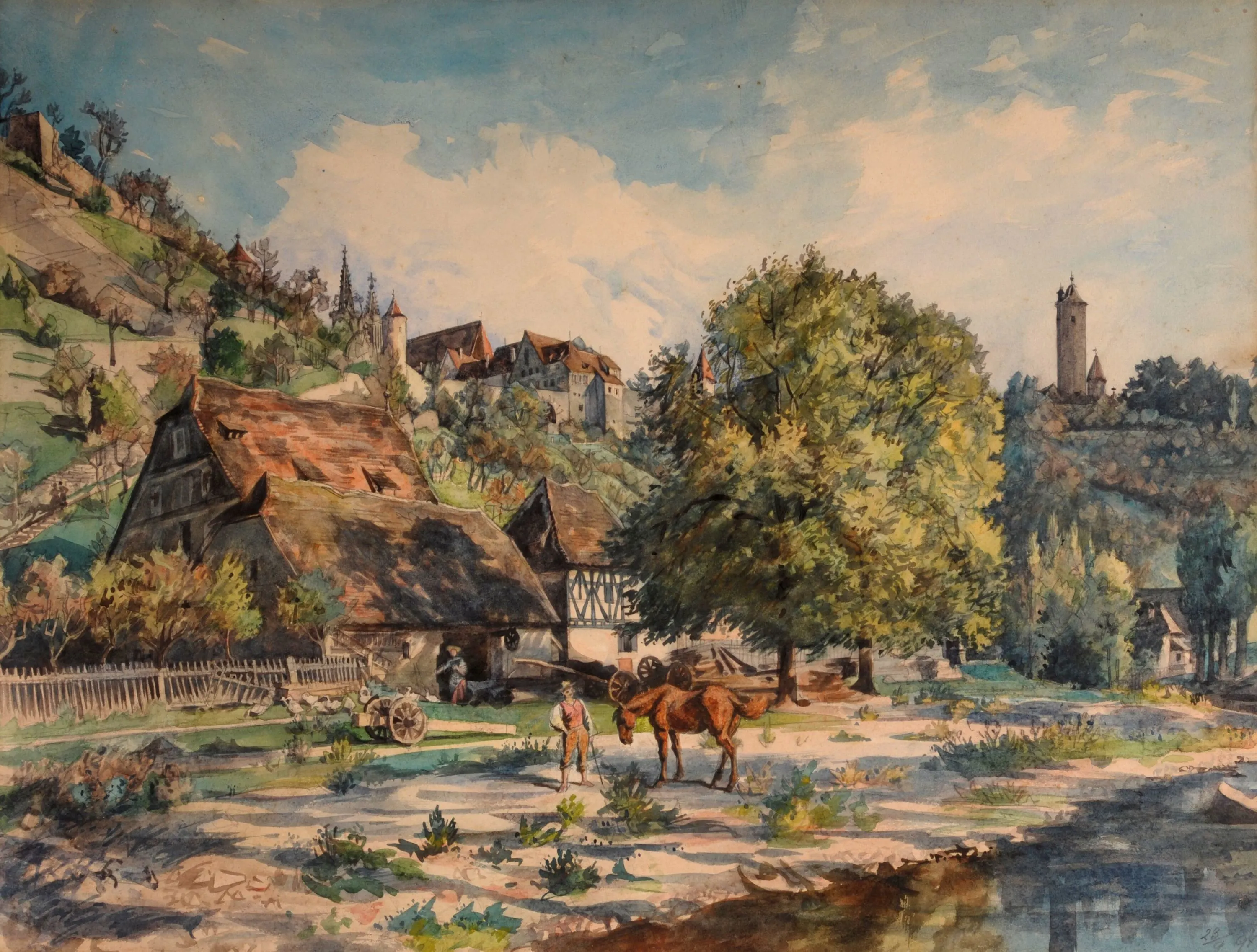
Imperial Town Museum
 Highlight of Rothenburg
Highlight of RothenburgTake a peek at what may be Germany's oldest kitchen and learn a bit of local lore and history.
Since 1936, the Imperial Town Museum located on Klosterhof street, has been housed in the former Dominican convent, which was dissolved in 1544. Visit the museum for an interesting experience of Rothenburg’s history and an impressive array of cultural artifacts and beautiful artwork. You can also visit the kitchen, which is said to date back to the late 1200s and is considered to be one of the oldest kitchens in Germany.
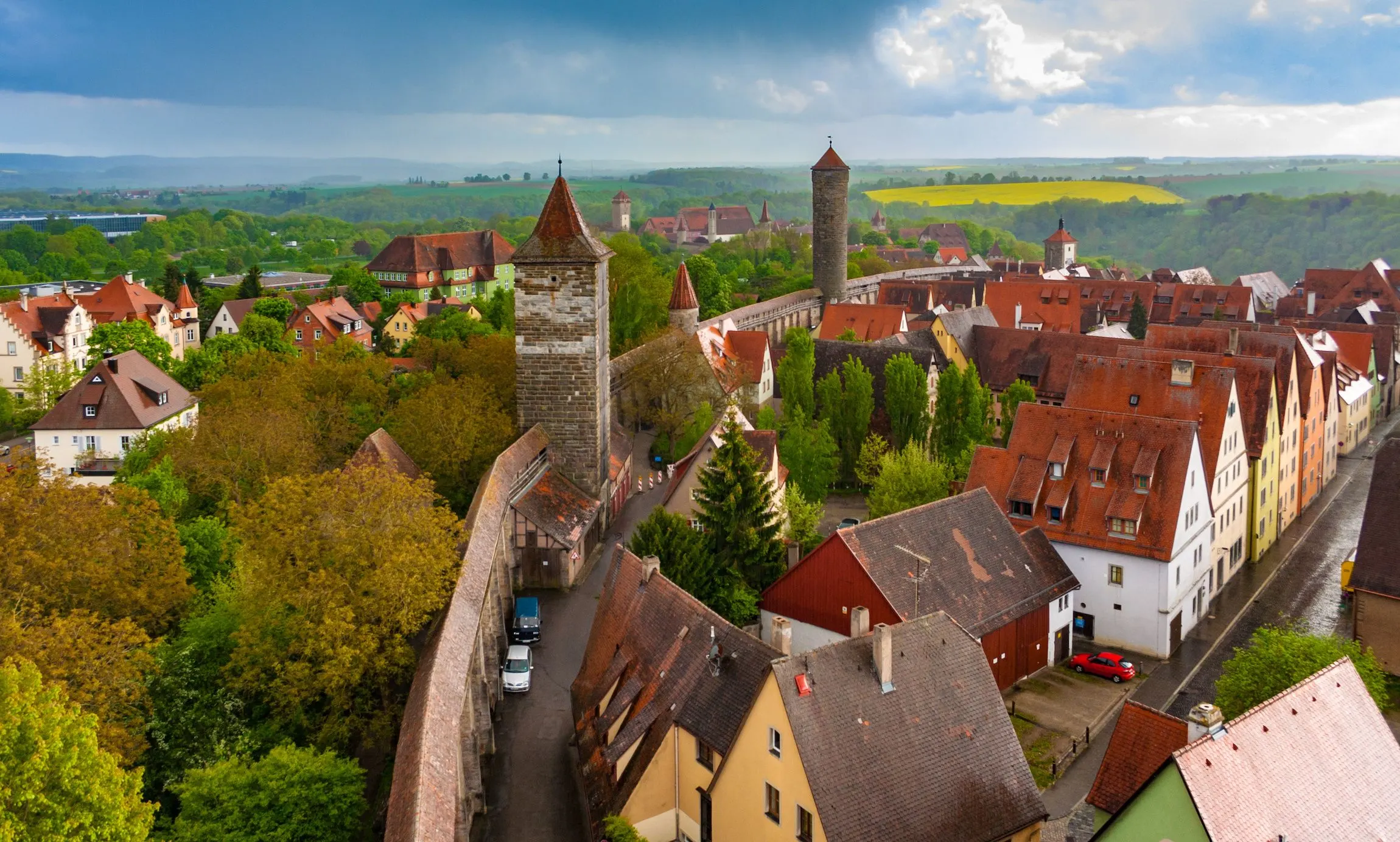
Rothenburg City Wall
 Highlight of Rothenburg
Highlight of RothenburgPeer over the red rooftops of Rothenburg as you walk its centuries-old battlements.
A must do while visiting Rothenburg is to take an hour or so to walk the historical walls around part of the Old Town. Stretching 2.5 miles (roughly 4km) around Rothenburg and guarded by 70 towers, walking around the covered ramparts of the Medieval City Wall is a magical experience. For those who wish to do a short section of the wall, you can start from the Rödertor Gateway which you may have passed through on entering the Old Town. For those adventurous travelers who wish to walk the whole wall, you can start from the Spitaltor, a massive round gatehouse located towards the south of the town, and continue to the final walkable gate, the Klingentor, located towards the north of the town. To start your walk, you simply need to climb the steep steps at the gate you wish to start. For those who are interested, a guided city wall tour is offered from the tourist information point next to the Market Square.
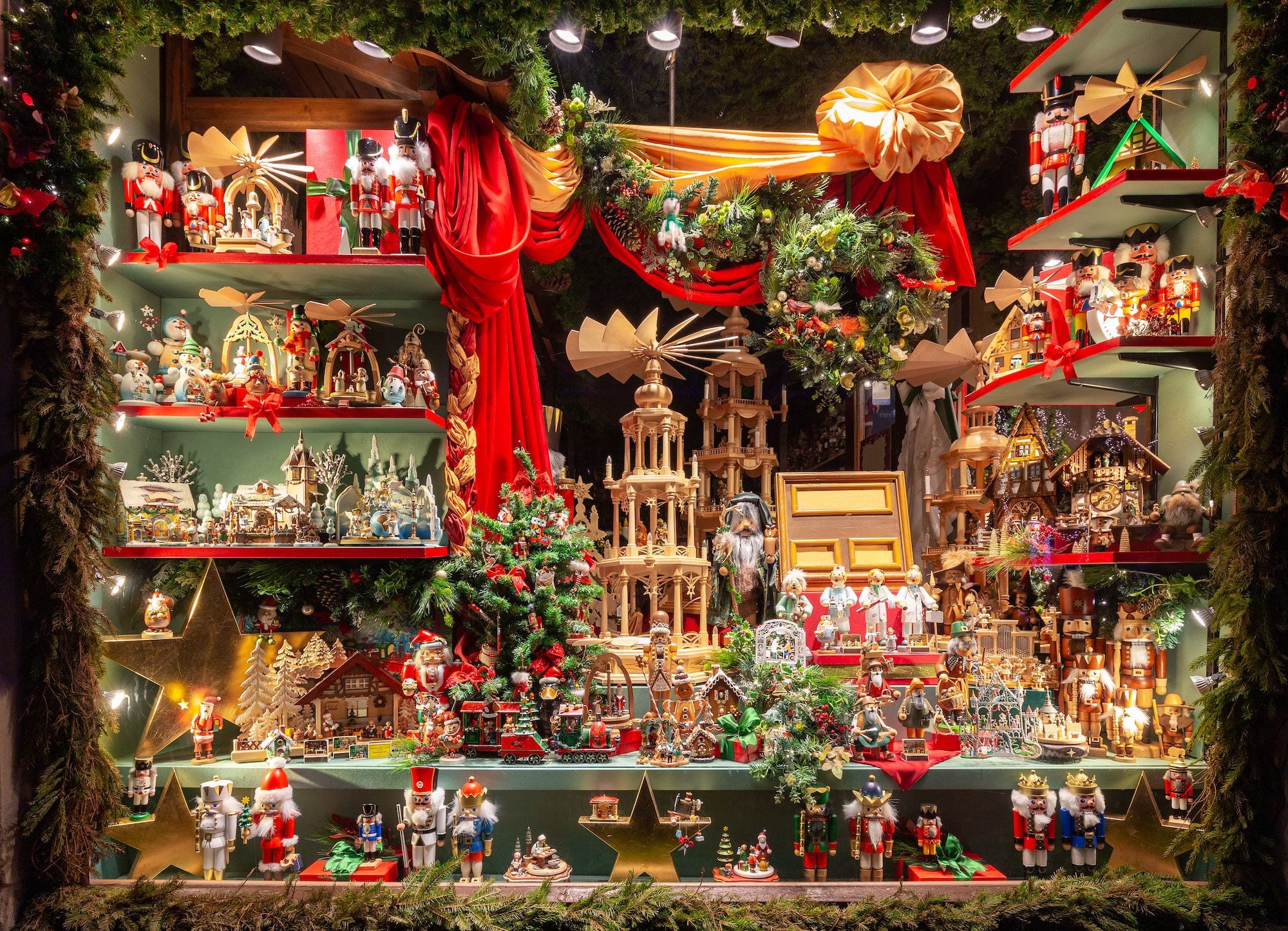
Christmas Store & German Christmas Museum
 Highlight of Rothenburg
Highlight of RothenburgExperience a traditional German Christmas, regardless of when you visit.
The famous Käthe Wohlfahrt Christmas decorations brand moved their flagship store in Rothenburg in 1977, and ever since, the town has been known for its unique Christmas Village and Museum. Next door to the store you will discover the German Christmas Museum. Covering over 2500 square foot, the museum covers hundreds of years of Christmas history and traditions in Germany.
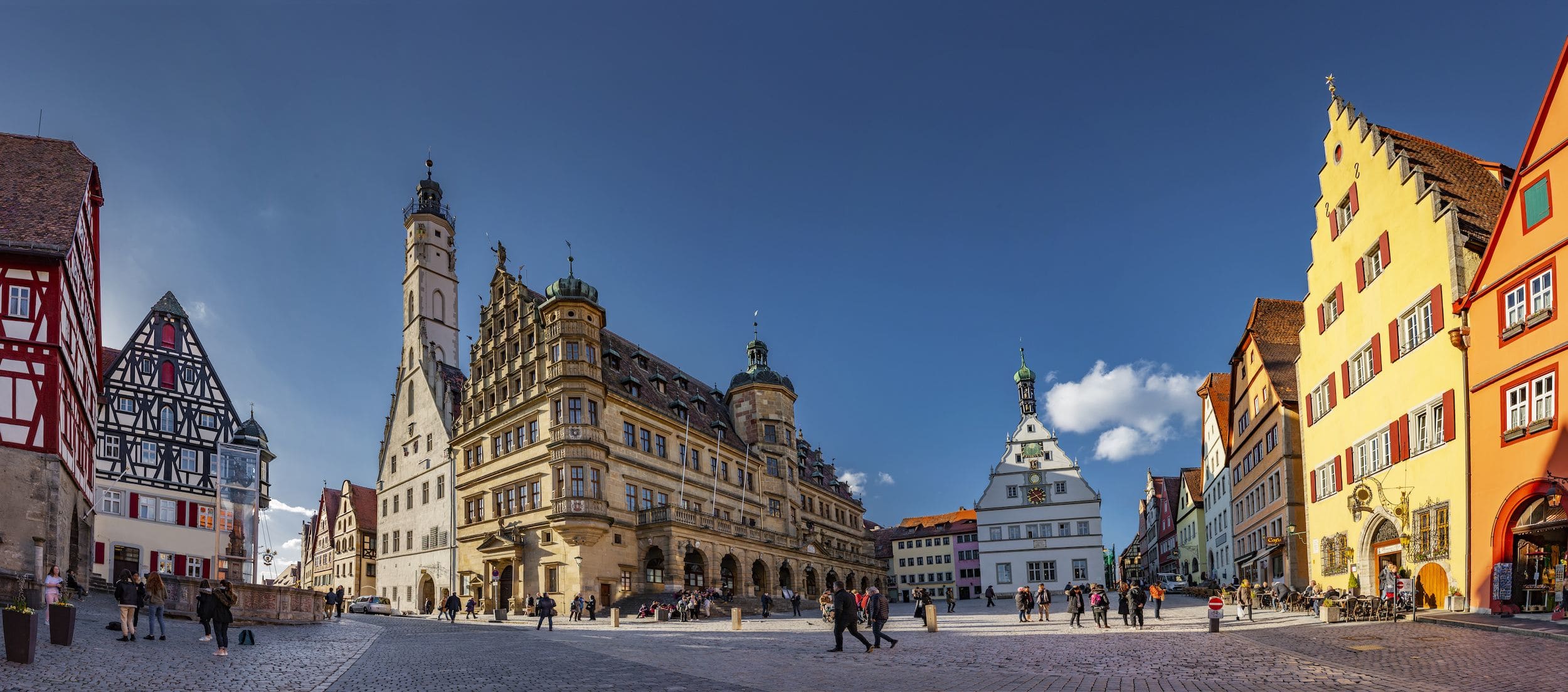
Rothenburg Market Square
 Highlight of Rothenburg
Highlight of RothenburgStop for a coffee or beer and enjoy the ambience in this lovely square.
The Market Square and Old Town Hall, surrounded by splendid patrician houses, is where all the action takes places and where you will find the majority of the Christmas Stalls during Advent. The white Ratstrinkstube building to the right of the town hall features a red clock, where every hour between 10 am and 10 pm clockwork figures entertain visitors below. For one of the best view of Rothenburg, head up the Town Hall Tower. As one of the tallest towers in the Rothenburg, it was an important part of the historical city’s defense. The main purpose of the tower was to watch for fires, providing a quick and easy way to communicate with the city wall towers. We recommend only the physically fit attempt to conquer its 222 steps and steep ladder to the observational gallery.
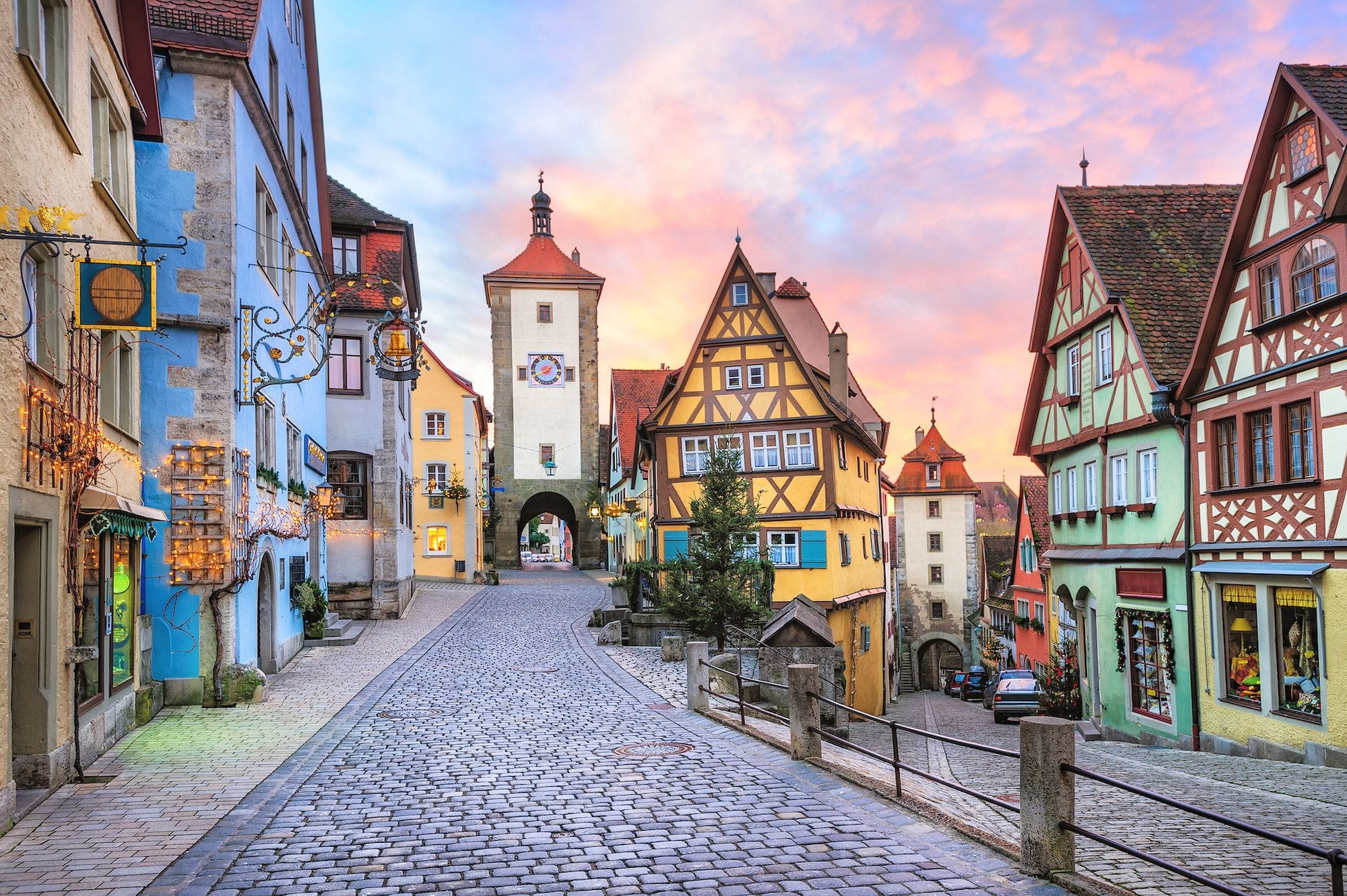
Plönlein (Little Square)
 Highlight of Rothenburg
Highlight of RothenburgSee one of the most photographed spots in Europe with your own eyes.
You will surely recognize this small square known as the “Plönlein” (Little Square). It's narrow half-timbered building with a small fountain in front, framed by the Kobolzeller tower is one of the most famous postcard images of Rothenburg ob der Tauber. In the summer, hordes of tourists come to this spot to take the same obligatory photo.

Imperial Town Museum
 Highlight of Rothenburg
Highlight of RothenburgTake a peek at what may be Germany's oldest kitchen and learn a bit of local lore and history.
Since 1936, the Imperial Town Museum located on Klosterhof street, has been housed in the former Dominican convent, which was dissolved in 1544. Visit the museum for an interesting experience of Rothenburg’s history and an impressive array of cultural artifacts and beautiful artwork. You can also visit the kitchen, which is said to date back to the late 1200s and is considered to be one of the oldest kitchens in Germany.

Rothenburg City Wall
 Highlight of Rothenburg
Highlight of RothenburgPeer over the red rooftops of Rothenburg as you walk its centuries-old battlements.
A must do while visiting Rothenburg is to take an hour or so to walk the historical walls around part of the Old Town. Stretching 2.5 miles (roughly 4km) around Rothenburg and guarded by 70 towers, walking around the covered ramparts of the Medieval City Wall is a magical experience. For those who wish to do a short section of the wall, you can start from the Rödertor Gateway which you may have passed through on entering the Old Town. For those adventurous travelers who wish to walk the whole wall, you can start from the Spitaltor, a massive round gatehouse located towards the south of the town, and continue to the final walkable gate, the Klingentor, located towards the north of the town. To start your walk, you simply need to climb the steep steps at the gate you wish to start. For those who are interested, a guided city wall tour is offered from the tourist information point next to the Market Square.

Christmas Store & German Christmas Museum
 Highlight of Rothenburg
Highlight of RothenburgExperience a traditional German Christmas, regardless of when you visit.
The famous Käthe Wohlfahrt Christmas decorations brand moved their flagship store in Rothenburg in 1977, and ever since, the town has been known for its unique Christmas Village and Museum. Next door to the store you will discover the German Christmas Museum. Covering over 2500 square foot, the museum covers hundreds of years of Christmas history and traditions in Germany.

Rothenburg Market Square
 Highlight of Rothenburg
Highlight of RothenburgStop for a coffee or beer and enjoy the ambience in this lovely square.
The Market Square and Old Town Hall, surrounded by splendid patrician houses, is where all the action takes places and where you will find the majority of the Christmas Stalls during Advent. The white Ratstrinkstube building to the right of the town hall features a red clock, where every hour between 10 am and 10 pm clockwork figures entertain visitors below. For one of the best view of Rothenburg, head up the Town Hall Tower. As one of the tallest towers in the Rothenburg, it was an important part of the historical city’s defense. The main purpose of the tower was to watch for fires, providing a quick and easy way to communicate with the city wall towers. We recommend only the physically fit attempt to conquer its 222 steps and steep ladder to the observational gallery.

Plönlein (Little Square)
 Highlight of Rothenburg
Highlight of RothenburgSee one of the most photographed spots in Europe with your own eyes.
You will surely recognize this small square known as the “Plönlein” (Little Square). It's narrow half-timbered building with a small fountain in front, framed by the Kobolzeller tower is one of the most famous postcard images of Rothenburg ob der Tauber. In the summer, hordes of tourists come to this spot to take the same obligatory photo.

Imperial Town Museum
 Highlight of Rothenburg
Highlight of RothenburgTake a peek at what may be Germany's oldest kitchen and learn a bit of local lore and history.
Since 1936, the Imperial Town Museum located on Klosterhof street, has been housed in the former Dominican convent, which was dissolved in 1544. Visit the museum for an interesting experience of Rothenburg’s history and an impressive array of cultural artifacts and beautiful artwork. You can also visit the kitchen, which is said to date back to the late 1200s and is considered to be one of the oldest kitchens in Germany.
prev
next

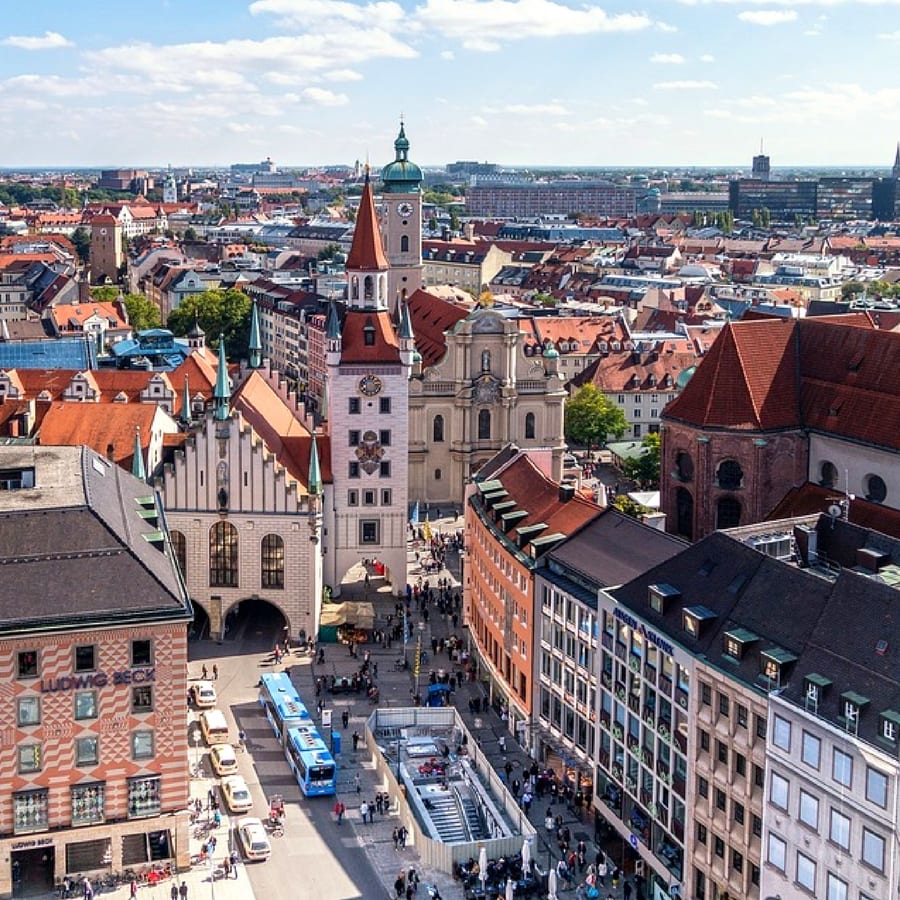
Day 6
Nuremberg to Munich
View More
Day 6
Nuremberg to Munich





9:20 AM
Transfer to Station by Taxi or Public Transport
Most trains depart from Nürnberg Hbf station, the largest station in the city. Before spending money on a transfer, be sure to check whether your hotel is within easy walking distance. Also consider that public transport is the cheapest and sometimes fastest option, and you can easily reach the station from almost anywhere in the city, as it is the public transport hub. Uber is not yet available in Nuremberg, but if staying at a hotel, they can order a reliable taxi. Some private transfers will even help with your bags.

Day 6
Nuremberg to Munich
View More


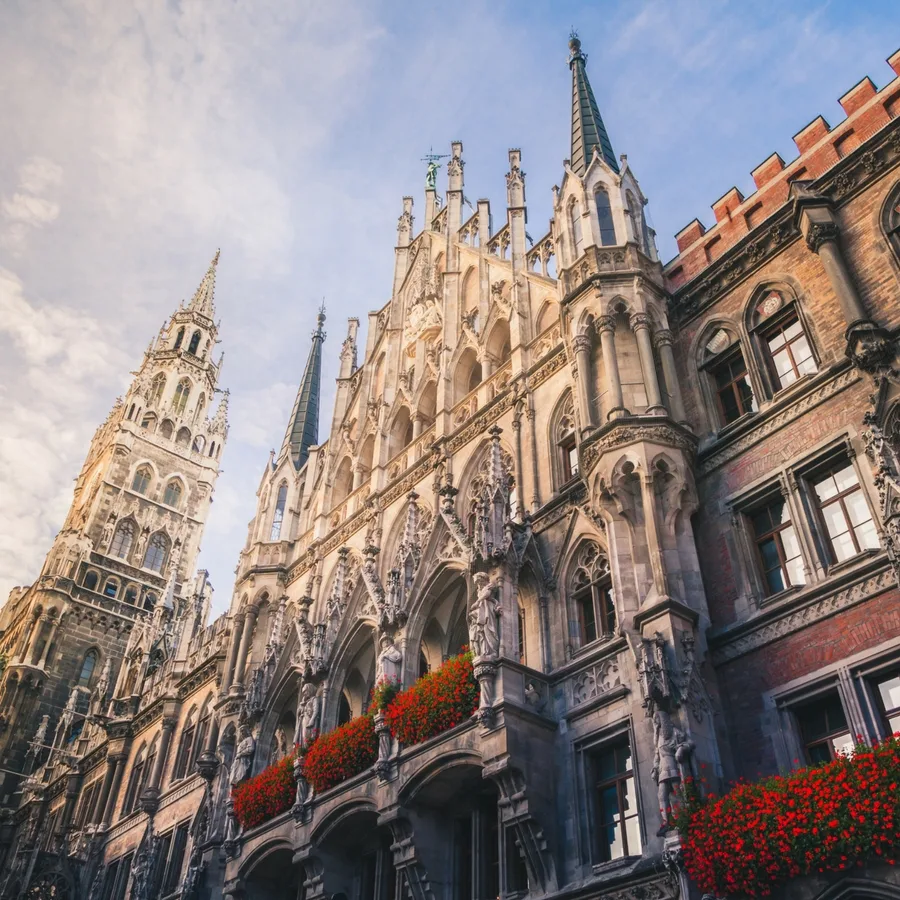
Day 7
Munich
View More
Day 7
Munich



9:00 AM - 11:30 AM
Guided Walk Tour of Historic Munich
Munich contains many reminders of a long and varied history but also encompasses the modern features of a strong and vibrant city. The insights of a local help make sense of the traditions, trends, and promises of Bavaria's Capital - sometimes referred to as the city of laptops and lederhosen. On this tour, your guide will show you the highlights of Munich and point out the many hidden treasures.

Day 7
Munich
View More


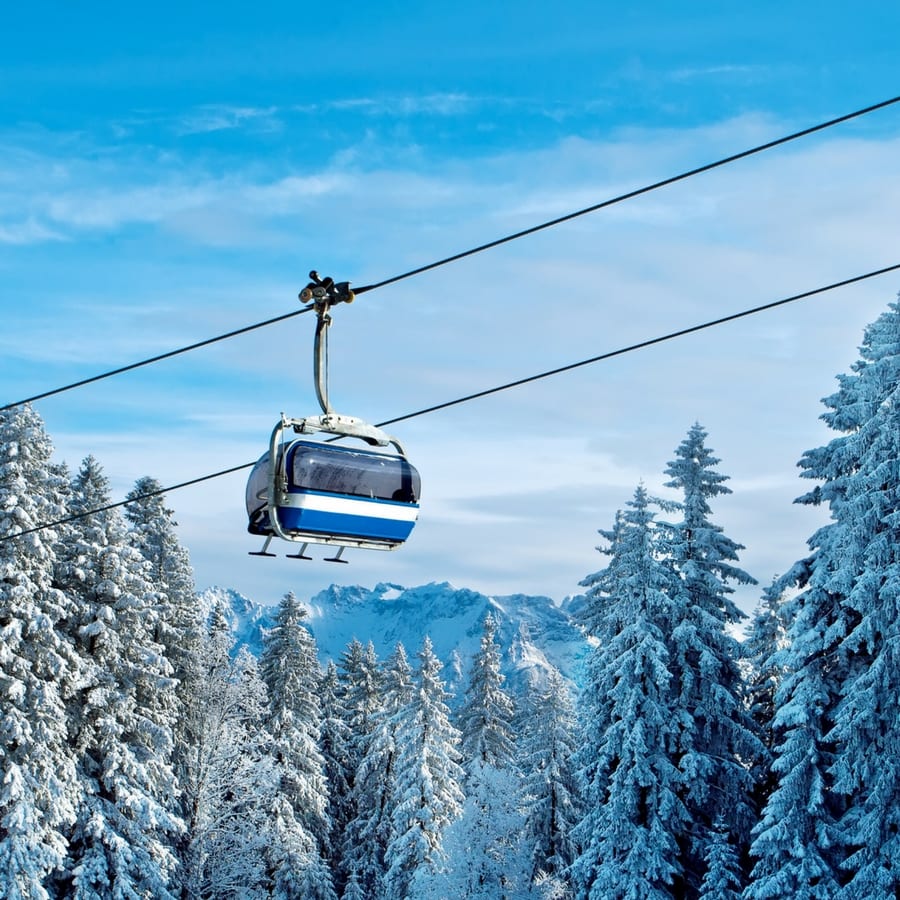
Day 8
Munich
View More
Day 8
Munich

Morning to Late Afternoon
Self Guided Excursion to Garmisch-Partenkirchen
Nestled in a magnificent setting at the foot of the Bavarian Alps, Garmisch-Partenkirchen is the German capital of summer hiking. The town has also been on the international winter-sports map ever since hosting the 1936 Winter Olympics. Once two different villages, Garmisch and Partenkirchen, the two halves of the town do show sharply contrasting characters: Garmisch is lively and international (in winter at least), while Partenkirchen better preserves its original Alpine charm. Perhaps the biggest draw for tourists is the opportunity to ride the famous Zugspitzbahn railway to Germany's tallest mountain, the Zugspitze.

Eibsee Lake
Hike to one of Bavaria's most picturesque spots.
Show More

Partnach Gorge
Venture deep within a stunning Alpine gorge.
Show More

Zugspitze
Take a ride on the famous Zugspitzbahn railway and a cable car to the peak of Germany's tallest mountain, the Zugspitze (2,962m or 9,718ft) for some truly breath-taking views.
Show More

Eibsee Lake
Hike to one of Bavaria's most picturesque spots.
Show More

Partnach Gorge
Venture deep within a stunning Alpine gorge.
Show More

Zugspitze
Take a ride on the famous Zugspitzbahn railway and a cable car to the peak of Germany's tallest mountain, the Zugspitze (2,962m or 9,718ft) for some truly breath-taking views.
Show More

Eibsee Lake
Hike to one of Bavaria's most picturesque spots.
Show More
prev
next

Day 8
Munich
View More

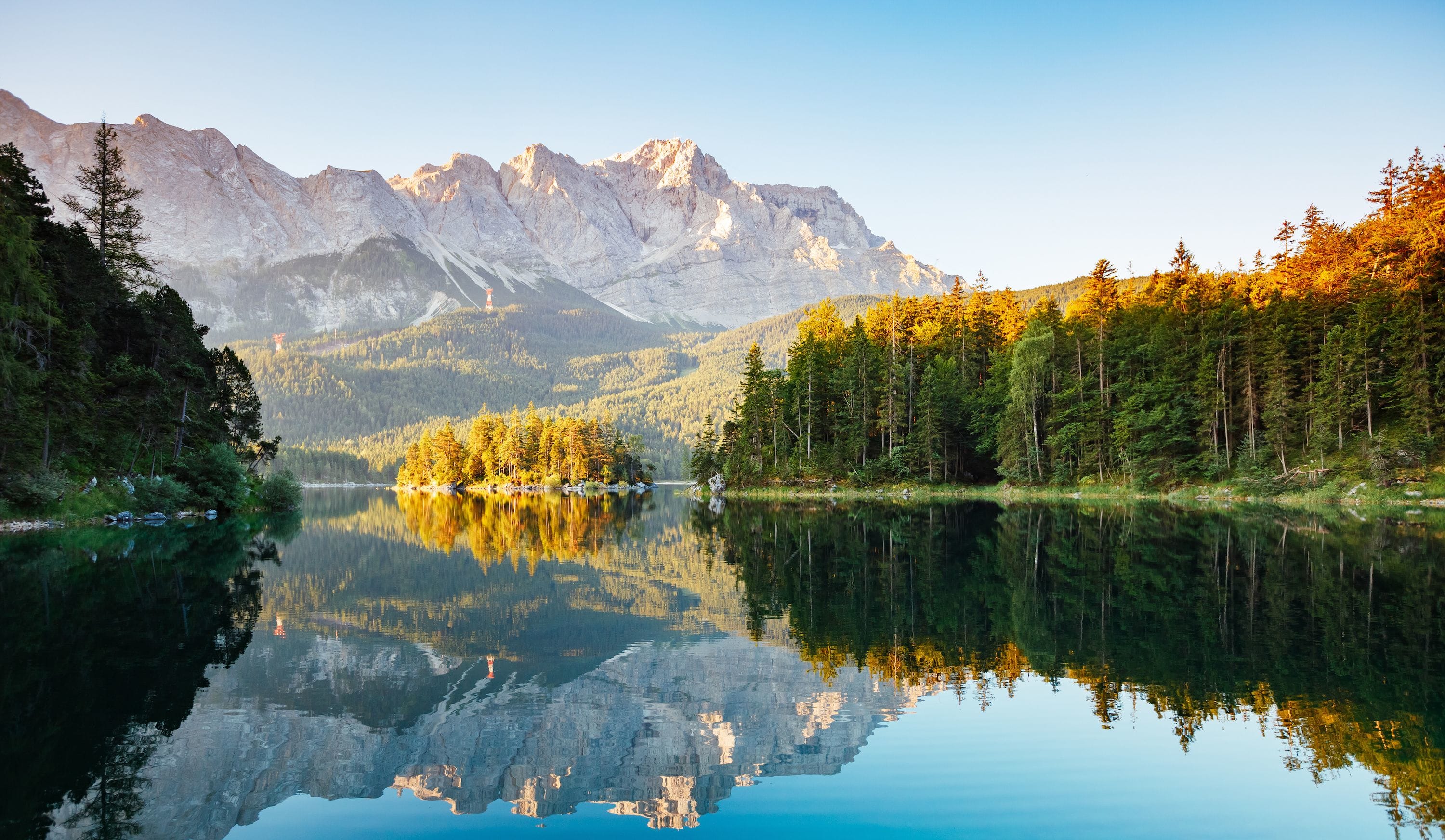
Eibsee Lake
 Highlight of Excursion to Garmisch-Partenkirchen
Highlight of Excursion to Garmisch-PartenkirchenHike to one of Bavaria's most picturesque spots.
If hiking is one of your goals in Garmisch and you're looking for a gentle option after descending from Zugspitze (or you don't wish to ascend the mountain at all), then we can heartily recommend the Eibsee Lake, which is, of course, one of the stops on the Zugspitzbahn. Just follow the signs to the lake (you can't miss it) and then the signs for the gentle 7.5km (4.6mi) hike around the lake shore while soaking up the stunning views. Avail yourself of the Eibsee beer garden after you get back to cool down.
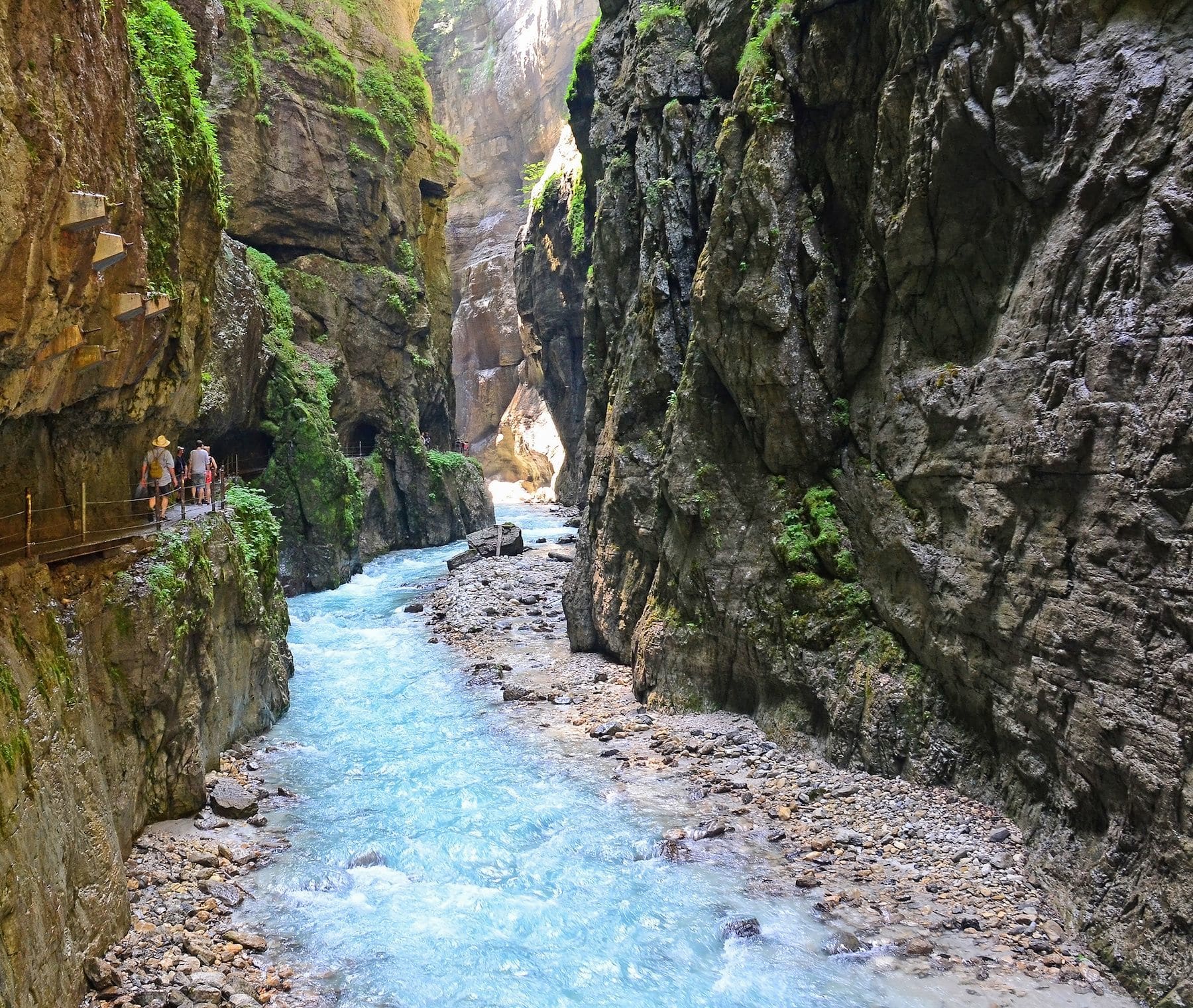
Partnach Gorge
 Highlight of Excursion to Garmisch-Partenkirchen
Highlight of Excursion to Garmisch-PartenkirchenVenture deep within a stunning Alpine gorge.
If you want to avoid the expense of the Zugspitzbahn, then an excellent short or long hiking option is to head south of the train station to the Partnachklamm (Partnach Gorge). The trail to the gorge starts from the Olympic Ski Stadium, which if you need to save time you can get to by city bus no.1 or no.2 directly from the train station rather walking 2km (1.25mi) to Skistadion. From there you follow the signs to the gorge, which is only 30min away (you can also take a horse-drawn carriage from the stadium).
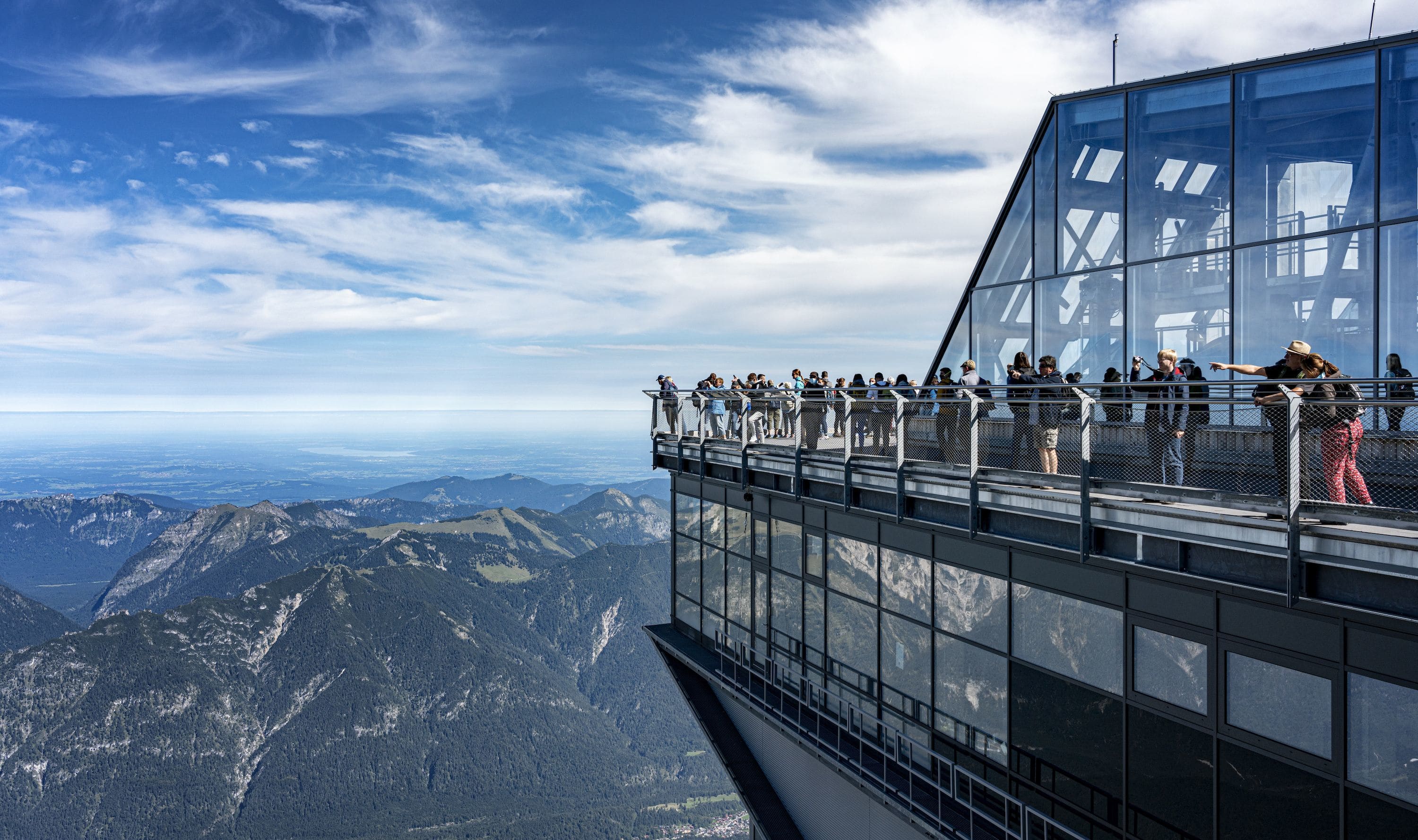
Zugspitze
 Highlight of Excursion to Garmisch-Partenkirchen
Highlight of Excursion to Garmisch-PartenkirchenTake a ride on the famous Zugspitzbahn railway and a cable car to the peak of Germany's tallest mountain, the Zugspitze (2,962m or 9,718ft) for some truly breath-taking views.
The Zugspitzbahn railway is the classic and breathtaking way of ascending Germany's highest peak, the Zugspitze (2962m or 9718ft). The line reaches as high as 2650m, making it the third-highest railway line in the world. The station and ticket office for the Zugspitzbahn trains (#3) is right beside the Garmisch-Partenkirchen train station. From here you take the purpose-built train along a cogwheel railway as far as Grainau - don't miss the wonderfully picturesque Pfarrkirche church that comes into view on the left as you near Grainau. In Grainau you'll change to a railcar that operates a rack-and-pinion system. The final 11.5km (7.1mi) gets steeper and steeper until you get just past the Eibsee station where you enter the 975m (3199ft) 'Rosi Tunnel'. You finally emerge at the Zugspitzplatt plateau on the Schneefen glacier below the Zugspitze peak. From there you journey to the summit on the ultramodern Gletscherbahn cable car (no extra ticket needed).

Eibsee Lake
 Highlight of Excursion to Garmisch-Partenkirchen
Highlight of Excursion to Garmisch-PartenkirchenHike to one of Bavaria's most picturesque spots.
If hiking is one of your goals in Garmisch and you're looking for a gentle option after descending from Zugspitze (or you don't wish to ascend the mountain at all), then we can heartily recommend the Eibsee Lake, which is, of course, one of the stops on the Zugspitzbahn. Just follow the signs to the lake (you can't miss it) and then the signs for the gentle 7.5km (4.6mi) hike around the lake shore while soaking up the stunning views. Avail yourself of the Eibsee beer garden after you get back to cool down.

Partnach Gorge
 Highlight of Excursion to Garmisch-Partenkirchen
Highlight of Excursion to Garmisch-PartenkirchenVenture deep within a stunning Alpine gorge.
If you want to avoid the expense of the Zugspitzbahn, then an excellent short or long hiking option is to head south of the train station to the Partnachklamm (Partnach Gorge). The trail to the gorge starts from the Olympic Ski Stadium, which if you need to save time you can get to by city bus no.1 or no.2 directly from the train station rather walking 2km (1.25mi) to Skistadion. From there you follow the signs to the gorge, which is only 30min away (you can also take a horse-drawn carriage from the stadium).

Zugspitze
 Highlight of Excursion to Garmisch-Partenkirchen
Highlight of Excursion to Garmisch-PartenkirchenTake a ride on the famous Zugspitzbahn railway and a cable car to the peak of Germany's tallest mountain, the Zugspitze (2,962m or 9,718ft) for some truly breath-taking views.
The Zugspitzbahn railway is the classic and breathtaking way of ascending Germany's highest peak, the Zugspitze (2962m or 9718ft). The line reaches as high as 2650m, making it the third-highest railway line in the world. The station and ticket office for the Zugspitzbahn trains (#3) is right beside the Garmisch-Partenkirchen train station. From here you take the purpose-built train along a cogwheel railway as far as Grainau - don't miss the wonderfully picturesque Pfarrkirche church that comes into view on the left as you near Grainau. In Grainau you'll change to a railcar that operates a rack-and-pinion system. The final 11.5km (7.1mi) gets steeper and steeper until you get just past the Eibsee station where you enter the 975m (3199ft) 'Rosi Tunnel'. You finally emerge at the Zugspitzplatt plateau on the Schneefen glacier below the Zugspitze peak. From there you journey to the summit on the ultramodern Gletscherbahn cable car (no extra ticket needed).

Eibsee Lake
 Highlight of Excursion to Garmisch-Partenkirchen
Highlight of Excursion to Garmisch-PartenkirchenHike to one of Bavaria's most picturesque spots.
If hiking is one of your goals in Garmisch and you're looking for a gentle option after descending from Zugspitze (or you don't wish to ascend the mountain at all), then we can heartily recommend the Eibsee Lake, which is, of course, one of the stops on the Zugspitzbahn. Just follow the signs to the lake (you can't miss it) and then the signs for the gentle 7.5km (4.6mi) hike around the lake shore while soaking up the stunning views. Avail yourself of the Eibsee beer garden after you get back to cool down.
prev
next

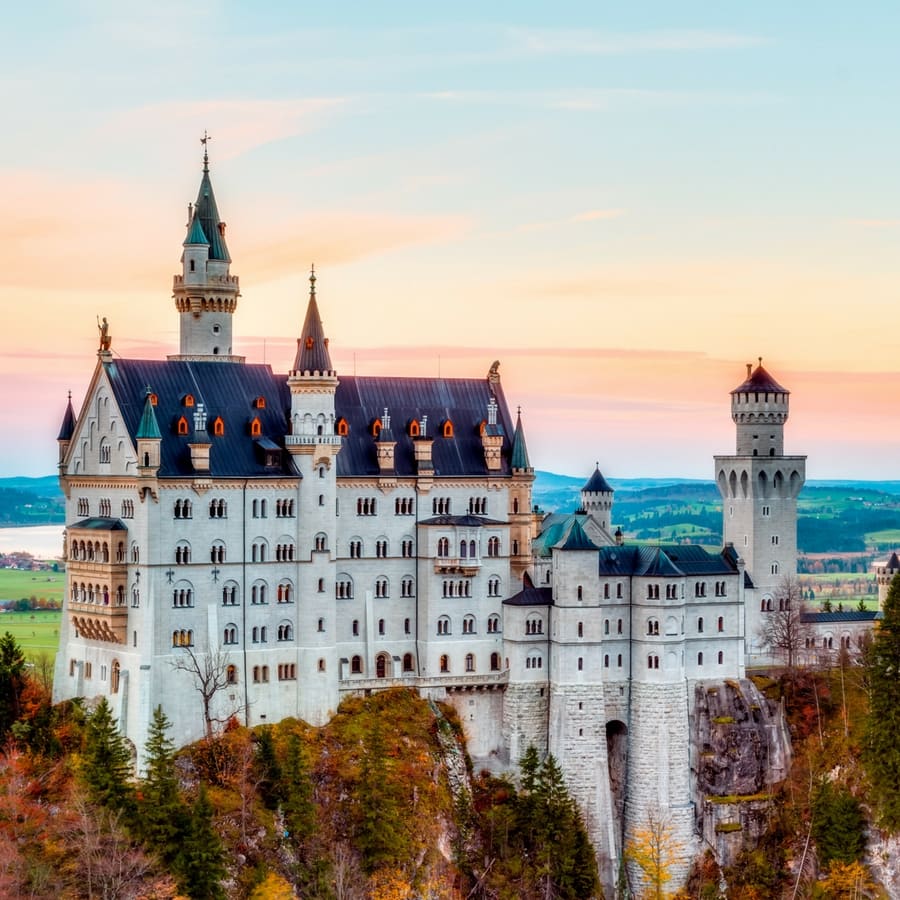
Day 9
Munich
View More
Day 9
Munich

Morning to Late Afternoon
Self Guided Excursion to Neuschwanstein Castle
An inspiration for the Disney Castles, numerous fairy tales, and countless dreamers, the Castle of Neuschwanstein is perhaps the most famous castle in the world. The eccentric Bavarian King Ludwig II created this amazing palace in the 19th century as an idyllic version of a medieval castle. You can visit by taking a guided tour from Munich or traveling independently by train and bus. In addition to enjoying spectacular views you can take a guided tour of the castle interior which is well worth the experience (but keep in mind that there a lots of steps to negotiate). If traveling independentally, be sure to book your interior tour reservations at least two days in advance.

Linderhof Palace
Stop by King Ludwig II's smallest palace on your way to Neuschwanstein and explore its delightful gardens.
Show More

Mary's Bridge
Enjoy a stunning view of the castle while suspended over a mountainous gorge.
Show More

Linderhof Palace
Stop by King Ludwig II's smallest palace on your way to Neuschwanstein and explore its delightful gardens.
Show More

Mary's Bridge
Enjoy a stunning view of the castle while suspended over a mountainous gorge.
Show More

Linderhof Palace
Stop by King Ludwig II's smallest palace on your way to Neuschwanstein and explore its delightful gardens.
Show More

Mary's Bridge
Enjoy a stunning view of the castle while suspended over a mountainous gorge.
Show More
prev
next

Day 9
Munich
View More


Linderhof Palace
 Highlight of Excursion to Neuschwanstein Castle
Highlight of Excursion to Neuschwanstein CastleStop by King Ludwig II's smallest palace on your way to Neuschwanstein and explore its delightful gardens.
Another of the eccentric (some say mad) King Ludwig II's creations is Linderhof Palace, which with its fantastic grotto and Moorish pavilion testifies to the king's vision. The smallest of his three palaces that he built, it is the only one that he lived to see completed. The palace is in between Munich and Neuschwanstein, meaning many tours stop there along the way.
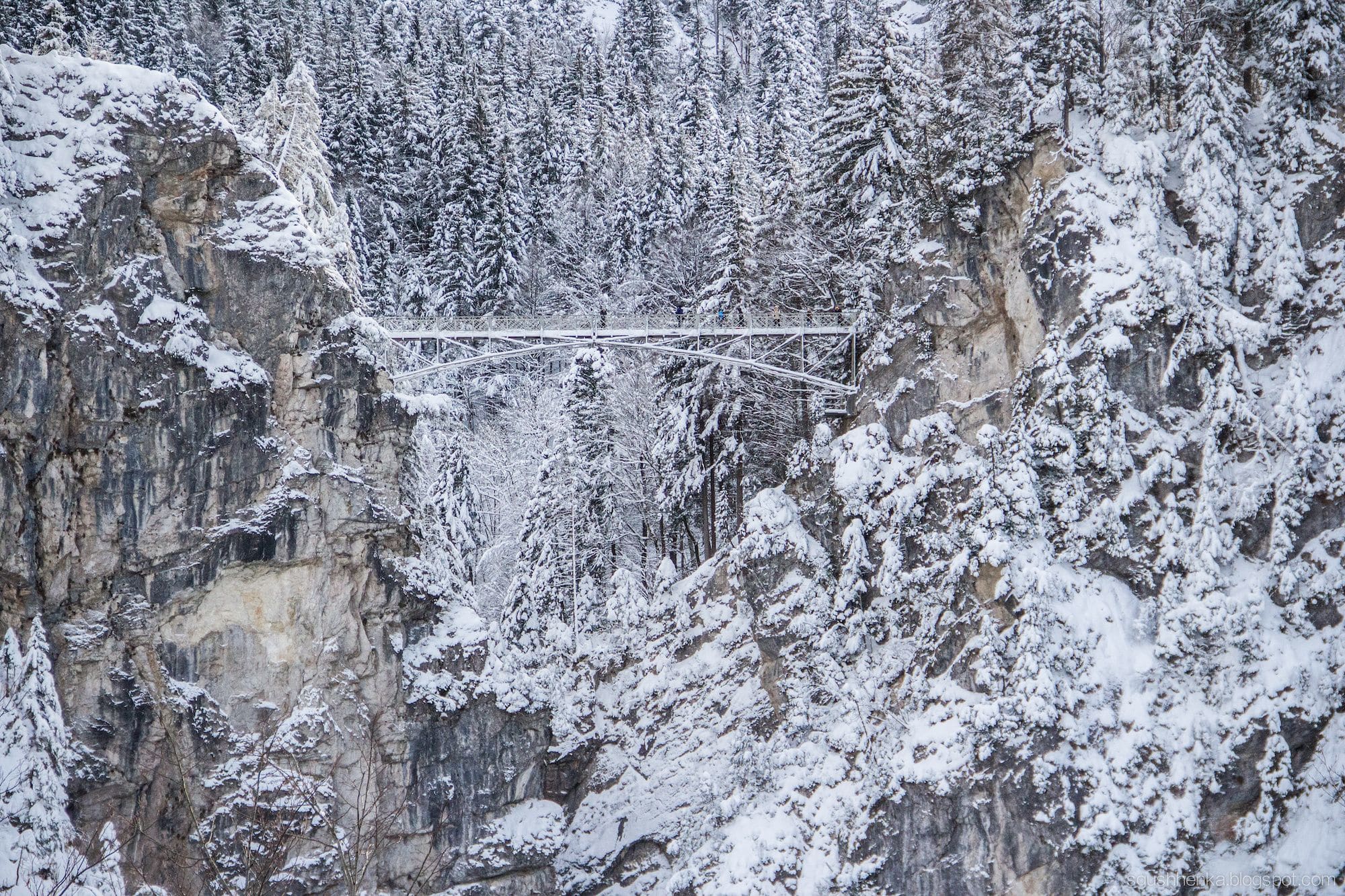
Mary's Bridge
 Highlight of Excursion to Neuschwanstein Castle
Highlight of Excursion to Neuschwanstein CastleEnjoy a stunning view of the castle while suspended over a mountainous gorge.
You definitely won't want to miss taking in the best views and photographs of Neuschwanstein from Marienbrücke (Mary's Bridge) over the dramatic Pöllat Gorge. The minibus terminal is very close at just 5 min walk away, while it's a steepish 10-15min climb on a wide and well-groomed path to get there from behind the castle. As noted above, Mary's Bridge can get a little crowded, so you might have to wait for a gap before you can fit on.

Linderhof Palace
 Highlight of Excursion to Neuschwanstein Castle
Highlight of Excursion to Neuschwanstein CastleStop by King Ludwig II's smallest palace on your way to Neuschwanstein and explore its delightful gardens.
Another of the eccentric (some say mad) King Ludwig II's creations is Linderhof Palace, which with its fantastic grotto and Moorish pavilion testifies to the king's vision. The smallest of his three palaces that he built, it is the only one that he lived to see completed. The palace is in between Munich and Neuschwanstein, meaning many tours stop there along the way.

Mary's Bridge
 Highlight of Excursion to Neuschwanstein Castle
Highlight of Excursion to Neuschwanstein CastleEnjoy a stunning view of the castle while suspended over a mountainous gorge.
You definitely won't want to miss taking in the best views and photographs of Neuschwanstein from Marienbrücke (Mary's Bridge) over the dramatic Pöllat Gorge. The minibus terminal is very close at just 5 min walk away, while it's a steepish 10-15min climb on a wide and well-groomed path to get there from behind the castle. As noted above, Mary's Bridge can get a little crowded, so you might have to wait for a gap before you can fit on.

Linderhof Palace
 Highlight of Excursion to Neuschwanstein Castle
Highlight of Excursion to Neuschwanstein CastleStop by King Ludwig II's smallest palace on your way to Neuschwanstein and explore its delightful gardens.
Another of the eccentric (some say mad) King Ludwig II's creations is Linderhof Palace, which with its fantastic grotto and Moorish pavilion testifies to the king's vision. The smallest of his three palaces that he built, it is the only one that he lived to see completed. The palace is in between Munich and Neuschwanstein, meaning many tours stop there along the way.

Mary's Bridge
 Highlight of Excursion to Neuschwanstein Castle
Highlight of Excursion to Neuschwanstein CastleEnjoy a stunning view of the castle while suspended over a mountainous gorge.
You definitely won't want to miss taking in the best views and photographs of Neuschwanstein from Marienbrücke (Mary's Bridge) over the dramatic Pöllat Gorge. The minibus terminal is very close at just 5 min walk away, while it's a steepish 10-15min climb on a wide and well-groomed path to get there from behind the castle. As noted above, Mary's Bridge can get a little crowded, so you might have to wait for a gap before you can fit on.
prev
next


Day 10
Depart Munich
View More
Day 10
Depart Munich

To Be Determined
Transfer to Airport by Taxi or Train
Munich has one main airport, Munich International Airport, where almost all visitors depart. The most affordable and often fastest way to reach the airport is by train. The "S-bahn" local trains takes 40 minutes and leaves directly from the main station in central Munich (München hbf). Other regional trains to the airport depart from other stations in Munich, so you may have an even better departure option near your hotel. Your hotel can arrange a reliable taxi or if you have the app, Uber is also a good option. You can also arrange a private transfer. If you are picked up about 3 hours before your departure time, you should arrive at the airport with a little over 2 hours to spare, depending on traffic. If you are leaving during rush hour, you may want to budget an extra fifteen to thirty minutes.

Day 10
Depart Munich
View More


What's Included In Your Trip

Pre-Paid Tours and Activities:
- Guided Walking Tour of the Heidelberg's Altstadt and Castle
- Guided Walking Tour of Nuremberg's Old Town & Imperial Castle Courtyards
- Guided Walk Tour of Historic Munich
- City Card for Munich, including discounts to many popular attractions

Pre-Paid Transportation:
- 2nd Class Train Tickets from Frankfurt to Mannheim
- 2nd Class Train Tickets from Mannheim to Heidelberg
- 2nd Class Train Tickets from Heidelberg to Stuttgart
- 2nd Class Train Tickets from Frankfurt to Nuremberg
- 2nd Class Train Tickets from Nuremberg-Munich
- Public Transport Tickets for Munich

Accommodation:
- 3 nights at a hotel of your choice in Heidelberg
- 4 nights at a hotel of your choice in Nuremberg
- 5 nights at a hotel of your choice in Munich

Go Real Travel Mobile App:
- Itinerary Plan & Reservations Info
- Points of Interest
- Detailed Travel Information
- Maps & Directions
Other Trips You May Like

17 Days
From$4530.9234235USD

4 Days
From$799USD

7 Days
From$1650USD
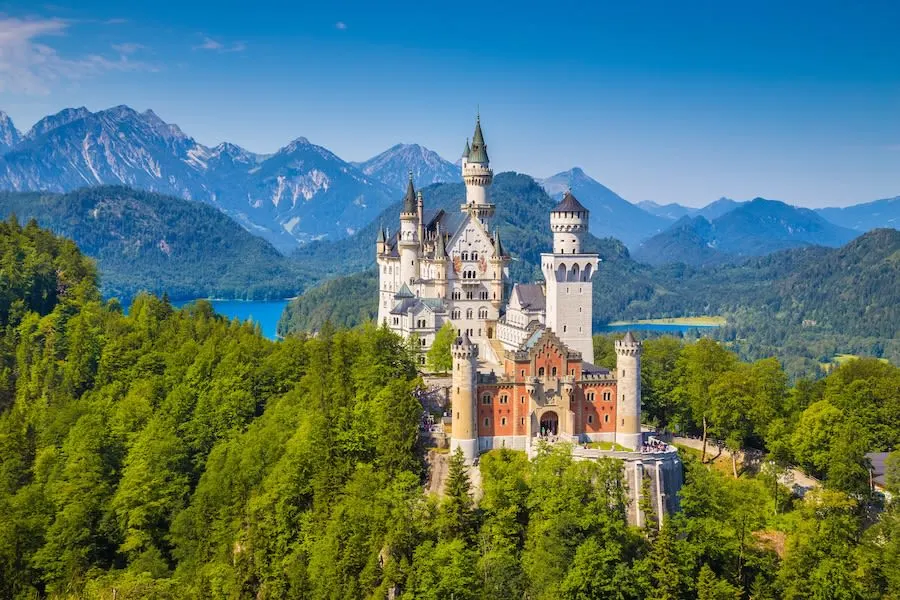
10 Days
From$1695USD
10 Day Munich and Prague Tour: Castles, Culture, and Beer Tasting Adventures

Germany, Czech Republic

21 Days
From$5199USD
Canals, Castles, and Culture: A Three-Week Journey in the Netherlands & Germany

Netherlands, Germany

21 Days
From$5899USD

10 Days
From$3250USD
Enchanting Christmas Market Trip to Bavaria & Prague with Gabriella-Maria

Germany, Czech Republic

10 Days
From$1415USD

14 Days
From$4050USD

17 Days
From$4530.9234235USD

4 Days
From$799USD

7 Days
From$1650USD

10 Days
From$1695USD
10 Day Munich and Prague Tour: Castles, Culture, and Beer Tasting Adventures

Germany, Czech Republic

21 Days
From$5199USD
Canals, Castles, and Culture: A Three-Week Journey in the Netherlands & Germany

Netherlands, Germany

21 Days
From$5899USD

10 Days
From$3250USD
Enchanting Christmas Market Trip to Bavaria & Prague with Gabriella-Maria

Germany, Czech Republic

10 Days
From$1415USD

14 Days
From$4050USD
prev
next
Featured Blogs
prev
next
Our Customers Say It Best
Otto Chuy, Los Angeles, California
I am still surprised how everything worked as planned, without a hitch. All instructions in your itinerary were precise and correct. Your suggestions and comments in each of the locations we went to were very helpful. All your guides, without exception, were wonderful and exactly on time. 

Kathy Mongeau, Ottawa, Ontario
My sister, Ann Ibberson, and I have been back home for a few weeks now and still go on and on about our fabulous trip. We were just blown away in every respect. Given the fact that we only had 1 ½ weeks, you had everything arranged for us so efficiently and your contacts who we dealt with for transfers, tours, hotels were extremely professional and personable. Things could not have gone better. 

Clive Andrew, Brisbane, Queensland
Just a quick note to let you know that I am back home now after probably the best overseas holiday that I have ever had, in no small part due to your very capable organization booking of hotels, tours, & trains. There was just nothing that went wrong with the timings etc. 

Malini Dutta, Boston, Massachusetts
We can't thank you enough for the detailed plans, maps, and suggestions. It really felt that someone was holding our hands and showing us around. We had all the excitement of discovering foreign lands, with none of the problems that can happen while negotiating unfamiliar places. In fact, all the cities felt like home within a few hours of arriving and exploring. 

Bev and Mark Frankel, Williamsburg, Virginia
We could not be more pleased with Go Real Travel! You took the guess work out of things like public transport but still managed to allow us the freedom to tour as we wanted. Our guides were exceptional and every time I saw a Viking Cruise tour of 25 people, I realized the quality experience we were getting with Go Real. 

Marianne Strydom, Paarl, South Africa
I just wanted to thank you for organizing an amazing trip for me – I packed in so much in such a short period of time and everything was just perfect. The way you do things makes it possible to really get to know the destination, which for me as a travel agent could not have been better. 

Otto Chuy, Los Angeles, California
I am still surprised how everything worked as planned, without a hitch. All instructions in your itinerary were precise and correct. Your suggestions and comments in each of the locations we went to were very helpful. All your guides, without exception, were wonderful and exactly on time. 

Kathy Mongeau, Ottawa, Ontario
My sister, Ann Ibberson, and I have been back home for a few weeks now and still go on and on about our fabulous trip. We were just blown away in every respect. Given the fact that we only had 1 ½ weeks, you had everything arranged for us so efficiently and your contacts who we dealt with for transfers, tours, hotels were extremely professional and personable. Things could not have gone better. 

Clive Andrew, Brisbane, Queensland
Just a quick note to let you know that I am back home now after probably the best overseas holiday that I have ever had, in no small part due to your very capable organization booking of hotels, tours, & trains. There was just nothing that went wrong with the timings etc. 

Malini Dutta, Boston, Massachusetts
We can't thank you enough for the detailed plans, maps, and suggestions. It really felt that someone was holding our hands and showing us around. We had all the excitement of discovering foreign lands, with none of the problems that can happen while negotiating unfamiliar places. In fact, all the cities felt like home within a few hours of arriving and exploring. 

Bev and Mark Frankel, Williamsburg, Virginia
We could not be more pleased with Go Real Travel! You took the guess work out of things like public transport but still managed to allow us the freedom to tour as we wanted. Our guides were exceptional and every time I saw a Viking Cruise tour of 25 people, I realized the quality experience we were getting with Go Real. 

Marianne Strydom, Paarl, South Africa
I just wanted to thank you for organizing an amazing trip for me – I packed in so much in such a short period of time and everything was just perfect. The way you do things makes it possible to really get to know the destination, which for me as a travel agent could not have been better. 



Explore cities in more detail
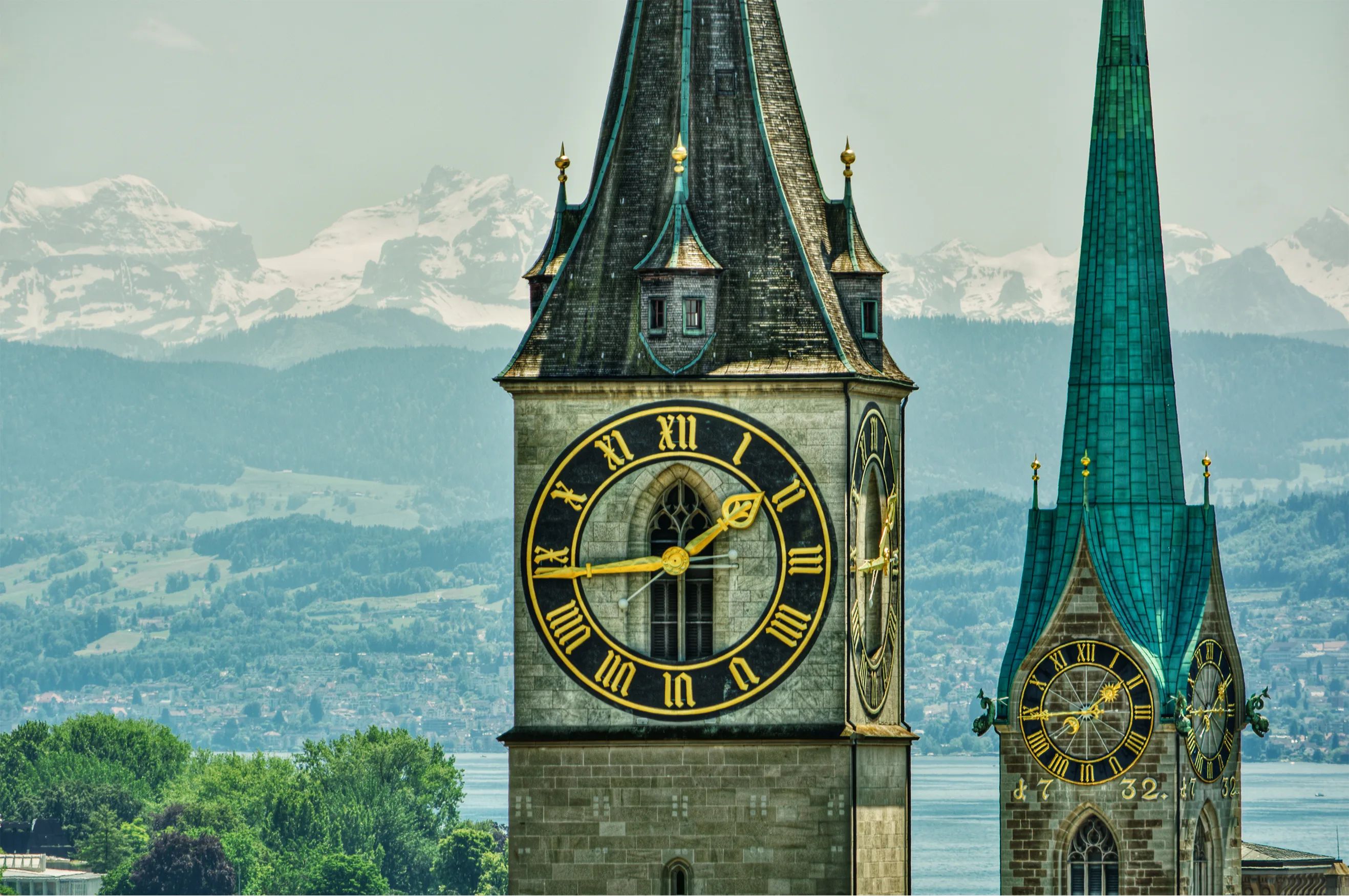
Zurich
Zurich is Switzerland’s biggest city, located in the center of the country’s German-speaking region. It’s this location, superbly connected to almost everywhere else by train and close to an international airport, that makes Zurich an obvious destination for tourists. Well, that’s one of the reasons. There’s also the city’s bevy of bars and restaurants, the lakeside views, and stunning architecture around every corner.Take a stroll down the Bahnhofstrasse, a street known around the world for its unrivaled shopping. Weave through crowds of shoppers as you pass rows of world-famous and exclusive brands. Zurich is a small city, but that just makes it easier to get around. Lindenhof Hill, a slight rise of land in the center, offers views across all of the town. Among the city’s most striking features are the Grossmünster towers, which can also be climbed. This is a proud, sophisticated, and elegant city.
Read More
Learn About Zurich
Build Zurich Trip
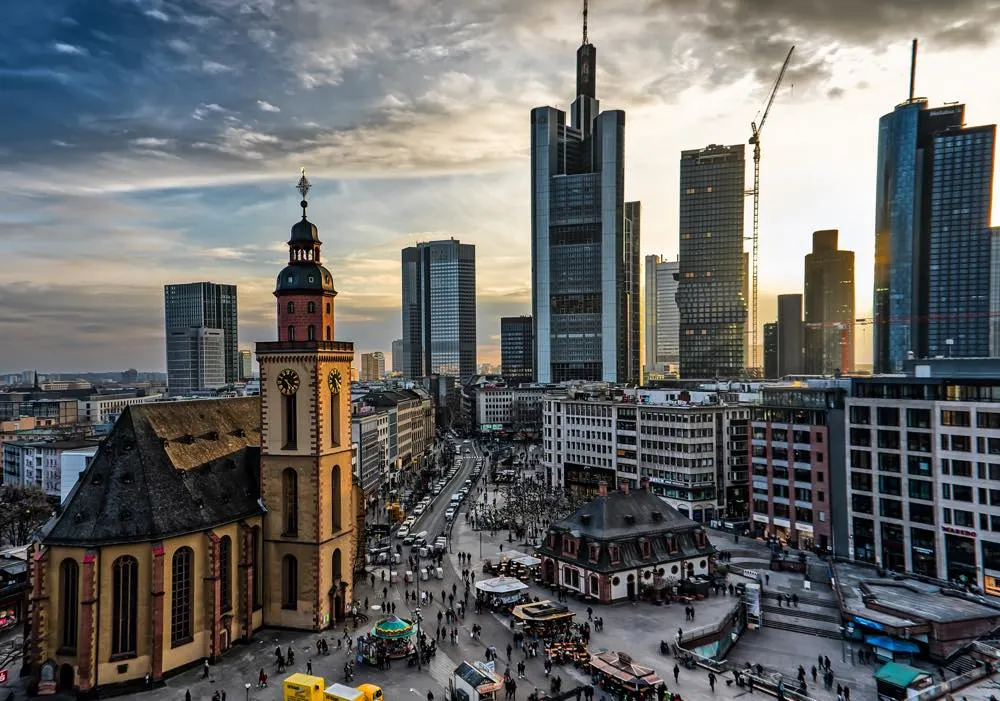
Frankfurt
Dubbed ‘Mainhatten’ for its glass highrises, financial prowess, and proximity to the Main River, Frankfurt offers a fascinating glimpse into the ‘engine room’ of Europe’s economy with an unexpected twist. Among the glass and steel buildings, the old-worldly Römerberg square will give you a double-take. The square’s 15th-century half-timbered houses, old statues, and church spires contrast dramatically against the modern 21st-century skyscrapers beyond. If you visit at Christmas, the Römerberg is truly special, aglow with the light of the tallest Christmas tree in Germany. The square fills with stalls selling handicrafts, and the air is scented with hot apple wine, honey, and cinnamon. Delve deeper into Frankfurt and you’ll find a substantial museum district, the Museumsufer (Museum Embankment). This area features a cluster of twelve museums on either side of Main River. This includes the Städel, home to Tischbein’s famous painting of renowned writer Johann Wolfgang von Goethe, one of Frankfurt’s most prestigious sons. The more time you spend in Frankfurt, the more you’ll discover a highly cultured city lurking beneath its glass facades. If you have the time, Frankfurt is certainly worth a second look.
Read More
Learn About Frankfurt
Build Frankfurt Trip
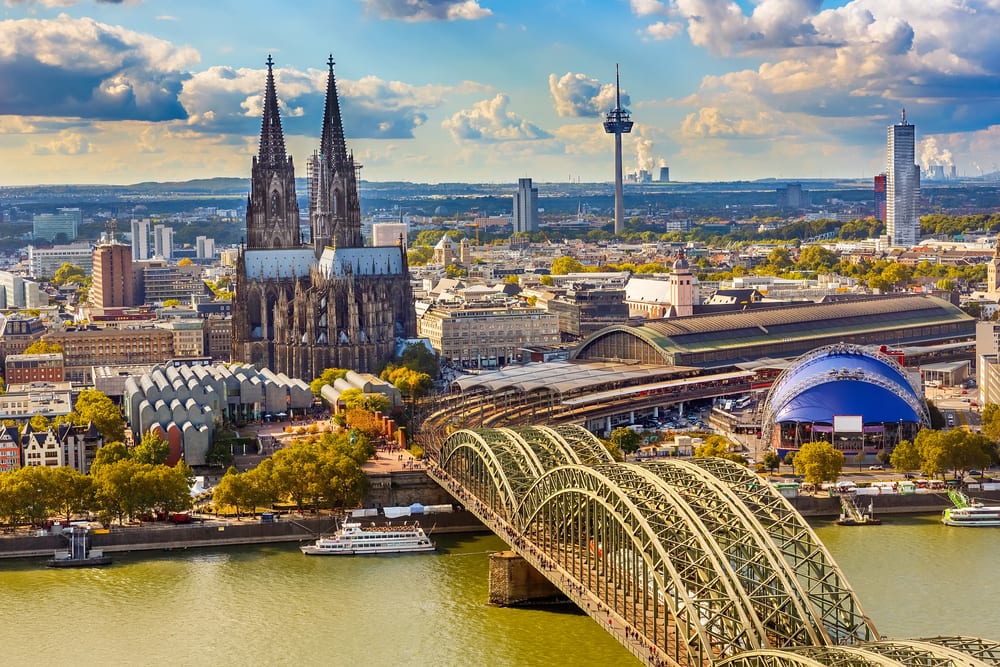
Cologne
As you travel through Western Germany, Cologne is a cheerful, fun city to stop for a night or two. Flanking both sides of the Rhine river, Cologne's delightful architectural pastiche reflects the breezy anything-goes attitude of its inhabitants. Like most German cities, Cologne took a hit during WWII, losing some of its old-world buildings and neighborhoods. However, thanks to the endurance of the Cologne Cathedral and iconic Hohenzollern Bridge, the city has kept its identity close to hand. Sometimes quite literally in the form of a glass of sparkling Kölsch local beer. A visit to Cologne should always include paying a call to its eponymous Cathedral. A sensational, Gothic behemoth of a building and a UNESCO Heritage Site, Cologne Cathedral will get you right in the heart, humbling all who enter it. Just outside the cathedral, the Hohenzollern Bridge spans the Rhine, with three iron truss arches looping over the river like the bounces of a skimming stone. After wandering the riverside, if you're looking for some indulgence, Cologne's Chocolate Museum is an eternally popular choice. Maybe you'll be under the influence of the cocoa, but at the end of a day in Cologne, life can seem pretty sweet.
Read More
Learn About Cologne
Build Cologne Trip
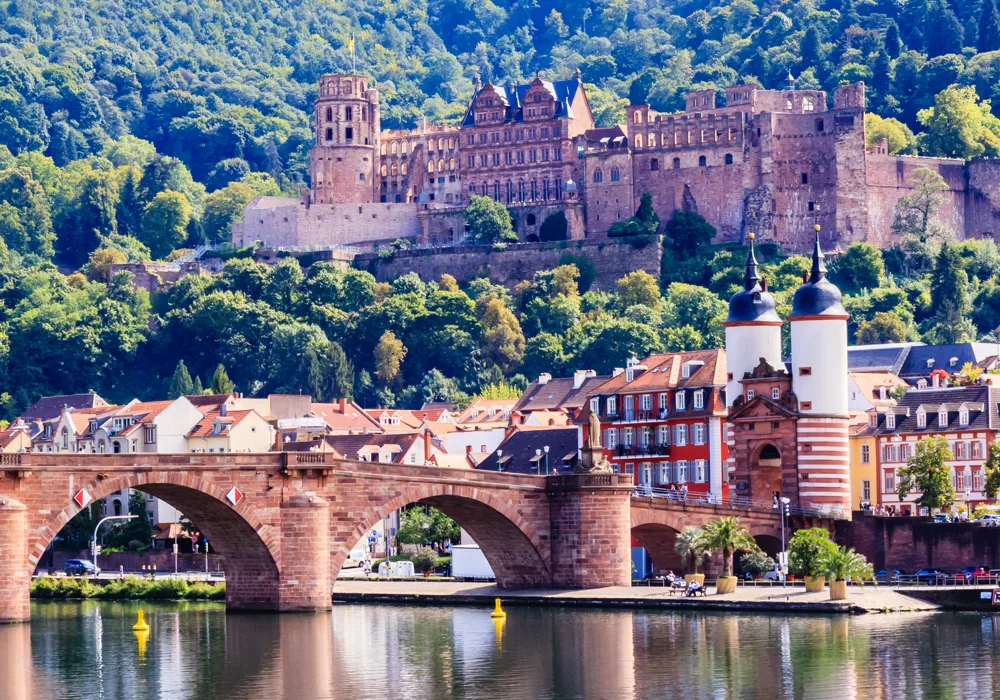
Heidelberg
Heidelberg is buried deep in the forests of southwest Germany. Flanking both sides of the Neckar River, Heidelberg's red and white baroque old town looks like something from a book of folktales. On the hillside above the town, you'll see the looming, tumbledown remains of Heidelberg's Gothic-Renaissance castle, Heidelberger Schloss. The subject of strange local legends, Heidelberg Castle was once home to knights, a famous court jester, and even a witch. It is said the first person who pulls out an iron ring embedded in one of the great doors will be the castle's true owner. Surely on your visit, it's worth a try? Across the river, follow in the footsteps of scholars on a hiking trail known as The Philosophers’ Way. Heidelberg University is the oldest in Germany, and its leafy, temple-like campus contributes to the gentle, contemplative atmosphere of the town. A poetic city with the dreamy feel of a watercolor painting, it's no wonder Heidelberg inspired writers like Mark Twain and Johann Wolfgang von Goethe. The city has even been recognized by UNESCO as a City of Literature. Especially on misty, grey days, Heidelberg has a way of sweeping you up in its romanticism.
Read More
Learn About Heidelberg
Build Heidelberg Trip
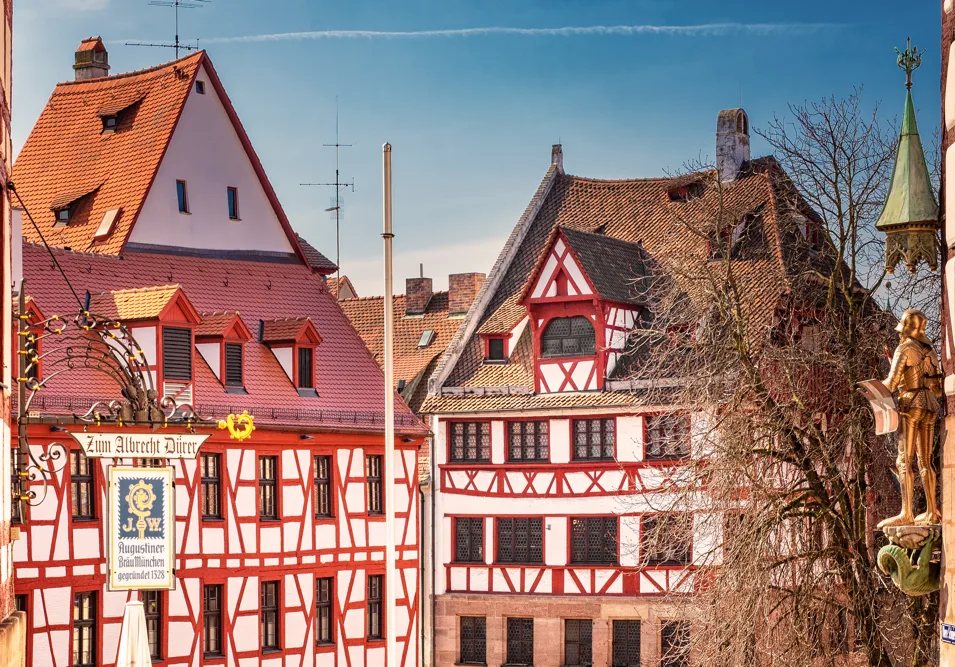
Nuremberg
One of the most authentic, storied German destinations, Nuremberg's picturesque old town, glorious castle, and buzzing Christmas Market makes this city a time-true classic. The ideal gateway to old Bavaria, Nuremberg offers a primer in German history before you embark on the lovely journey through old Bavaria, known as the Romantic Road. Considered the capital of the Holy Roman Empire in the middle ages, Nuremberg would have felt like the center of the world as a procession of kings and emperors passed through its magnificent gates. When the German Renaissance came, Nuremberg was at its heart. Albrecht Dürer, the great German master artist, was born here, and Martin Luther called Nuremberg Germany's 'eyes and ears'. Skip forward a few centuries, and the city took a dark turn, as Nuremberg became a gathering point for the German National Socialists. Slightly outside of town, you can still find the Nazi Party Rallying Grounds, a sobering reminder of the not so distant past. If it all gets too heavy, you can end the day with a glass of rotbier (red beer) and mull it over. Nuremberg is a must-see for anyone who wants to delve into Germany's past.
Read More
Learn About Nuremberg
Build Nuremberg Trip
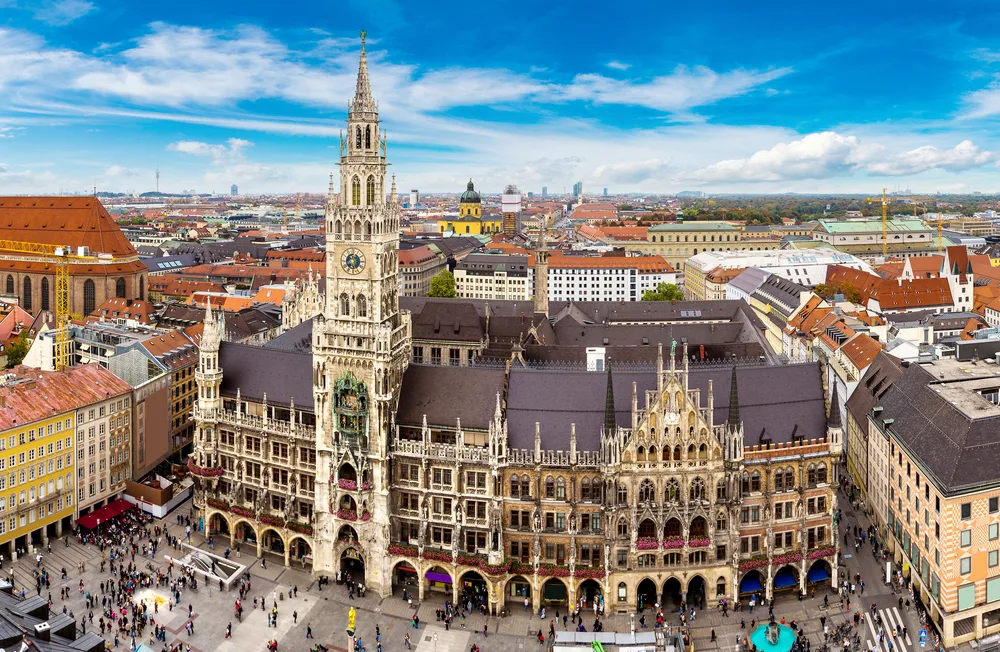
Munich
Arriving in Munich, you would be forgiven for thinking you were on the set of a movie about old Bavaria. At the Old Town beer halls, barmaids laced in dirndl dresses serve up frosty Helles lager, as oom-pah music drifts across the Marienplatz square. Men in lederhosen and checked shirts merrily give toasts as they knock glasses, or steins, as they’re known here. They sit at tables laden with wurst sausage and giant pretzels oozing with herby butter. This is Germany’s Germany, a place where folk traditions never stopped, and the revelry doesn’t either. Even when it isn’t Oktoberfest, the town’s notorious beer-drinking celebration, Munich is always happy to show you a good time. Simply cast your eyes around the lavish, gilded banquet hall at the Munich Residenz, the 13th-century Wittelsbach palace. You’ll see Munich has been impressing guests for centuries. Or, swing by the BMW Museum and check out the classic German cars. They even let you sit inside to test out the new models. At the city’s English Gardens, surfers ride waves on one of the park’s rivers. Munich is filled to the brim with this kind of pure-hearted German fun.
Read More
Learn About Munich
Build Munich Trip

Zurich
Zurich is Switzerland’s biggest city, located in the center of the country’s German-speaking region. It’s this location, superbly connected to almost everywhere else by train and close to an international airport, that makes Zurich an obvious destination for tourists. Well, that’s one of the reasons. There’s also the city’s bevy of bars and restaurants, the lakeside views, and stunning architecture around every corner.Take a stroll down the Bahnhofstrasse, a street known around the world for its unrivaled shopping. Weave through crowds of shoppers as you pass rows of world-famous and exclusive brands. Zurich is a small city, but that just makes it easier to get around. Lindenhof Hill, a slight rise of land in the center, offers views across all of the town. Among the city’s most striking features are the Grossmünster towers, which can also be climbed. This is a proud, sophisticated, and elegant city.
Read More
Learn About Zurich
Build Zurich Trip

Frankfurt
Dubbed ‘Mainhatten’ for its glass highrises, financial prowess, and proximity to the Main River, Frankfurt offers a fascinating glimpse into the ‘engine room’ of Europe’s economy with an unexpected twist. Among the glass and steel buildings, the old-worldly Römerberg square will give you a double-take. The square’s 15th-century half-timbered houses, old statues, and church spires contrast dramatically against the modern 21st-century skyscrapers beyond. If you visit at Christmas, the Römerberg is truly special, aglow with the light of the tallest Christmas tree in Germany. The square fills with stalls selling handicrafts, and the air is scented with hot apple wine, honey, and cinnamon. Delve deeper into Frankfurt and you’ll find a substantial museum district, the Museumsufer (Museum Embankment). This area features a cluster of twelve museums on either side of Main River. This includes the Städel, home to Tischbein’s famous painting of renowned writer Johann Wolfgang von Goethe, one of Frankfurt’s most prestigious sons. The more time you spend in Frankfurt, the more you’ll discover a highly cultured city lurking beneath its glass facades. If you have the time, Frankfurt is certainly worth a second look.
Read More
Learn About Frankfurt
Build Frankfurt Trip

Cologne
As you travel through Western Germany, Cologne is a cheerful, fun city to stop for a night or two. Flanking both sides of the Rhine river, Cologne's delightful architectural pastiche reflects the breezy anything-goes attitude of its inhabitants. Like most German cities, Cologne took a hit during WWII, losing some of its old-world buildings and neighborhoods. However, thanks to the endurance of the Cologne Cathedral and iconic Hohenzollern Bridge, the city has kept its identity close to hand. Sometimes quite literally in the form of a glass of sparkling Kölsch local beer. A visit to Cologne should always include paying a call to its eponymous Cathedral. A sensational, Gothic behemoth of a building and a UNESCO Heritage Site, Cologne Cathedral will get you right in the heart, humbling all who enter it. Just outside the cathedral, the Hohenzollern Bridge spans the Rhine, with three iron truss arches looping over the river like the bounces of a skimming stone. After wandering the riverside, if you're looking for some indulgence, Cologne's Chocolate Museum is an eternally popular choice. Maybe you'll be under the influence of the cocoa, but at the end of a day in Cologne, life can seem pretty sweet.
Read More
Learn About Cologne
Build Cologne Trip

Heidelberg
Heidelberg is buried deep in the forests of southwest Germany. Flanking both sides of the Neckar River, Heidelberg's red and white baroque old town looks like something from a book of folktales. On the hillside above the town, you'll see the looming, tumbledown remains of Heidelberg's Gothic-Renaissance castle, Heidelberger Schloss. The subject of strange local legends, Heidelberg Castle was once home to knights, a famous court jester, and even a witch. It is said the first person who pulls out an iron ring embedded in one of the great doors will be the castle's true owner. Surely on your visit, it's worth a try? Across the river, follow in the footsteps of scholars on a hiking trail known as The Philosophers’ Way. Heidelberg University is the oldest in Germany, and its leafy, temple-like campus contributes to the gentle, contemplative atmosphere of the town. A poetic city with the dreamy feel of a watercolor painting, it's no wonder Heidelberg inspired writers like Mark Twain and Johann Wolfgang von Goethe. The city has even been recognized by UNESCO as a City of Literature. Especially on misty, grey days, Heidelberg has a way of sweeping you up in its romanticism.
Read More
Learn About Heidelberg
Build Heidelberg Trip

Nuremberg
One of the most authentic, storied German destinations, Nuremberg's picturesque old town, glorious castle, and buzzing Christmas Market makes this city a time-true classic. The ideal gateway to old Bavaria, Nuremberg offers a primer in German history before you embark on the lovely journey through old Bavaria, known as the Romantic Road. Considered the capital of the Holy Roman Empire in the middle ages, Nuremberg would have felt like the center of the world as a procession of kings and emperors passed through its magnificent gates. When the German Renaissance came, Nuremberg was at its heart. Albrecht Dürer, the great German master artist, was born here, and Martin Luther called Nuremberg Germany's 'eyes and ears'. Skip forward a few centuries, and the city took a dark turn, as Nuremberg became a gathering point for the German National Socialists. Slightly outside of town, you can still find the Nazi Party Rallying Grounds, a sobering reminder of the not so distant past. If it all gets too heavy, you can end the day with a glass of rotbier (red beer) and mull it over. Nuremberg is a must-see for anyone who wants to delve into Germany's past.
Read More
Learn About Nuremberg
Build Nuremberg Trip

Munich
Arriving in Munich, you would be forgiven for thinking you were on the set of a movie about old Bavaria. At the Old Town beer halls, barmaids laced in dirndl dresses serve up frosty Helles lager, as oom-pah music drifts across the Marienplatz square. Men in lederhosen and checked shirts merrily give toasts as they knock glasses, or steins, as they’re known here. They sit at tables laden with wurst sausage and giant pretzels oozing with herby butter. This is Germany’s Germany, a place where folk traditions never stopped, and the revelry doesn’t either. Even when it isn’t Oktoberfest, the town’s notorious beer-drinking celebration, Munich is always happy to show you a good time. Simply cast your eyes around the lavish, gilded banquet hall at the Munich Residenz, the 13th-century Wittelsbach palace. You’ll see Munich has been impressing guests for centuries. Or, swing by the BMW Museum and check out the classic German cars. They even let you sit inside to test out the new models. At the city’s English Gardens, surfers ride waves on one of the park’s rivers. Munich is filled to the brim with this kind of pure-hearted German fun.
Read More
Learn About Munich
Build Munich Trip
prev
next


 Map of Your Itinerary Route
Map of Your Itinerary Route
Zoom In to the cities to see your itinerary in more detail


 4.8
4.8 
